Building Blocks - Applications¶
Here are some examples that use the basic PRU building blocks.
The following are resources used in this chapter.
Note
Resources
Memory Allocation¶
Problem¶
I want to control where my variables are stored in memory.
Solution¶
Each PRU has is own 8KB of data memory (Data Mem0 and Mem1) and 12KB of shared memory (Shared RAM) as shown in PRU Block Diagram.
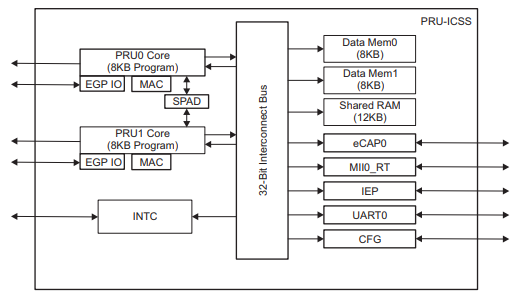
Fig. 501 PRU Block Diagram¶
Each PRU accesses its own DRAM starting at location 0x0000_0000. Each PRU can also access the other PRU’s DRAM starting at 0x0000_2000. Both PRUs access the shared RAM at 0x0001_0000. The compiler can control where each of these memories variables are stored.
shared.pro0.c - Examples of Using Different Memory Locations shows how to allocate seven variable in six different locations.
1// From: http://git.ti.com/pru-software-support-package/pru-software-support-package/blobs/master/examples/am335x/PRU_access_const_table/PRU_access_const_table.c
2#include <stdint.h>
3#include <pru_cfg.h>
4#include <pru_ctrl.h>
5#include "resource_table_empty.h"
6
7#define PRU_SRAM __far __attribute__((cregister("PRU_SHAREDMEM", near)))
8#define PRU_DMEM0 __far __attribute__((cregister("PRU_DMEM_0_1", near)))
9#define PRU_DMEM1 __far __attribute__((cregister("PRU_DMEM_1_0", near)))
10
11/* NOTE: Allocating shared_x to PRU Shared Memory means that other PRU cores on
12 * the same subsystem must take care not to allocate data to that memory.
13 * Users also cannot rely on where in shared memory these variables are placed
14 * so accessing them from another PRU core or from the ARM is an undefined behavior.
15 */
16volatile uint32_t shared_0;
17PRU_SRAM volatile uint32_t shared_1;
18PRU_DMEM0 volatile uint32_t shared_2;
19PRU_DMEM1 volatile uint32_t shared_3;
20#pragma DATA_SECTION(shared_4, ".bss")
21volatile uint32_t shared_4;
22
23/* NOTE: Here we pick where in memory to store shared_5. The stack and
24 * heap take up the first 0x200 words, so we must start after that.
25 * Since we are hardcoding where things are stored we can share
26 * this between the PRUs and the ARM.
27*/
28#define PRU0_DRAM 0x00000 // Offset to DRAM
29// Skip the first 0x200 bytes of DRAM since the Makefile allocates
30// 0x100 for the STACK and 0x100 for the HEAP.
31volatile unsigned int *shared_5 = (unsigned int *) (PRU0_DRAM + 0x200);
32
33
34int main(void)
35{
36 volatile uint32_t shared_6;
37 volatile uint32_t shared_7;
38 /*****************************************************************/
39 /* Access PRU peripherals using Constant Table & PRU header file */
40 /*****************************************************************/
41
42 /* Clear SYSCFG[STANDBY_INIT] to enable OCP master port */
43 CT_CFG.SYSCFG_bit.STANDBY_INIT = 0;
44
45 /*****************************************************************/
46 /* Access PRU Shared RAM using Constant Table */
47 /*****************************************************************/
48
49 /* C28 defaults to 0x00000000, we need to set bits 23:8 to 0x0100 in order to have it point to 0x00010000 */
50 PRU0_CTRL.CTPPR0_bit.C28_BLK_POINTER = 0x0100;
51
52 shared_0 = 0xfeef;
53 shared_1 = 0xdeadbeef;
54 shared_2 = shared_2 + 0xfeed;
55 shared_3 = 0xdeed;
56 shared_4 = 0xbeed;
57 shared_5[0] = 0x1234;
58 shared_6 = 0x4321;
59 shared_7 = 0x9876;
60
61 /* Halt PRU core */
62 __halt();
63}
Discussion¶
Here’s the line-by-line
Line |
Explanation |
|---|---|
7 |
PRU_SRAM is defined here. It will be used later to declare variables in the Shared RAM location of memory. Section 5.5.2 on page 75 of the PRU Optimizing C/C++ Compiler, v2.2, User’s Guide gives details of the command. The PRU_SHAREDMEM refers to the memory section defined in am335x_pru.cmd on line 26. |
8, 9 |
These are like the previous line except for the DMEM sections. |
16 |
Variables declared outside of main() are put on the heap. |
17 |
Adding PRU_SRAM has the variable stored in the shared memory. |
18, 19 |
These are stored in the PRU’s local RAM. |
20, 21 |
These lines are for storing in the .bss section as declared on line 74 of am335x_pru.cmd. |
28-31 |
All the previous examples direct the compiler to an area in memory and the compilers figures out what to put where. With these lines we specify the exact location. Here are start with the PRU_DRAM starting address and add 0x200 to it to avoid the stack and the heap. The advantage of this technique is you can easily share these variables between the ARM and the two PRUs. |
36, 37 |
Variable declared inside main() go on the stack. |
Caution
Using the technique of line 28-31 you can put variables anywhere, even where the compiler has put them. Be careful, it’s easy to overwrite what the compiler has done
Compile and run the program.
bone$ *source shared_setup.sh*
TARGET=shared.pru0
Black Found
P9_31
Current mode for P9_31 is: pruout
Current mode for P9_31 is: pruout
P9_29
Current mode for P9_29 is: pruout
Current mode for P9_29 is: pruout
P9_30
Current mode for P9_30 is: pruout
Current mode for P9_30 is: pruout
P9_28
Current mode for P9_28 is: pruout
Current mode for P9_28 is: pruout
bone$ *make*
/opt/source/pru-cookbook-code/common/Makefile:29: MODEL=TI_AM335x_BeagleBone_Black,TARGET=shared.pru0
- Stopping PRU 0
- copying firmware file /tmp/vsx-examples/shared.pru0.out to /lib/firmware/am335x-pru0-fw
write_init_pins.sh
- Starting PRU 0
MODEL = TI_AM335x_BeagleBone_Black
PROC = pru
PRUN = 0
PRU_DIR = /sys/class/remoteproc/remoteproc1
Now check the symbol table to see where things are allocated.
bone $ *grep shared /tmp/vsx-examples/shared.pru0.map*
....
1 0000011c shared_0
2 00010000 shared_1
1 00000000 shared_2
1 00002000 shared_3
1 00000118 shared_4
1 00000120 shared_5
We see, shared_0 had no directives and was places in the heap that is 0x100
to 0x1ff. shared_1 was directed to go to the SHAREDMEM, shared_2 to
the start of the local DRAM (which is also the top of the stack). shared_3
was placed in the DRAM of PRU 1, shared_4 was placed in the .bss section,
which is in the heap. Finally shared_5 is a pointer to where the value
is stored.
Where are shared_6 and shared_7? They are declared inside main() and are
therefore placed on the stack at run time. The shared.map file shows the
compile time allocations. We have to look in the memory itself to see what
happen at run time.
Let’s fire up prudebug (prudebug - A Simple Debugger for the PRU) to see where things are.
bone$ *sudo ./prudebug*
PRU Debugger v0.25
(C) Copyright 2011, 2013 by Arctica Technologies. All rights reserved.
Written by Steven Anderson
Using /dev/mem device.
Processor type AM335x
PRUSS memory address 0x4a300000
PRUSS memory length 0x00080000
offsets below are in 32-bit byte addresses (not ARM byte addresses)
PRU Instruction Data Ctrl
0 0x00034000 0x00000000 0x00022000
1 0x00038000 0x00002000 0x00024000
PRU0> *d 0*
Absolute addr = 0x0000, offset = 0x0000, Len = 16
[0x0000] 0x0000feed 0x00000000 0x00000000 0x00000000
[0x0010] 0x00000000 0x00000000 0x00000000 0x00000000
[0x0020] 0x00000000 0x00000000 0x00000000 0x00000000
[0x0030] 0x00000000 0x00000000 0x00000000 0x00000000
The value of shared_2 is in memory location 0.
PRU0> *dd 0x100*
Absolute addr = 0x0100, offset = 0x0000, Len = 16
[0x0100] 0x00000000 0x00000001 0x00000000 0x00000000
[0x0110] 0x00000000 0x00000000 0x0000beed 0x0000feef
[0x0120] 0x00000200 0x3ec71de3 0x1a013e1a 0xbf2a01a0
[0x0130] 0x111110b0 0x3f811111 0x55555555 0xbfc55555
There are shared_0 and shared_4 in the heap, but where is shared_6 and
shared_7? They are supposed to be on the stack that starts at 0.
PRU0> dd *0xc0*
Absolute addr = 0x00c0, offset = 0x0000, Len = 16
[0x00c0] 0x00000000 0x00000000 0x00000000 0x00000000
[0x00d0] 0x00000000 0x00000000 0x00000000 0x00000000
[0x00e0] 0x00000000 0x00000000 0x00000000 0x00000000
[0x00f0] 0x00000000 0x00000000 0x00004321 0x00009876
There they are; the stack grows from the top. (The heap grows from the bottom.)
PRU0> dd *0x2000*
Absolute addr = 0x2000, offset = 0x0000, Len = 16
[0x2000] 0x0000deed 0x00000001 0x00000000 0x557fcfb5
[0x2010] 0xce97bd0f 0x6afb2c8f 0xc7f35df4 0x5afb6dcb
[0x2020] 0x8dec3da3 0xe39a6756 0x642cb8b8 0xcb6952c0
[0x2030] 0x2f22ebda 0x548d97c5 0x9241786f 0x72dfeb86
And there is PRU 1’s memory with shared_3. And finally the shared memory.
PRU0> *dd 0x10000*
Absolute addr = 0x10000, offset = 0x0000, Len = 16
[0x10000] 0xdeadbeef 0x0000feed 0x00000000 0x68c44f8b
[0x10010] 0xc372ba7e 0x2ffa993b 0x11c66da5 0xfbf6c5d7
[0x10020] 0x5ada3fcf 0x4a5d0712 0x48576fb7 0x1004796b
[0x10030] 0x2267ebc6 0xa2793aa1 0x100d34dc 0x9ca06d4a
The compiler offers great control over where variables are stored. Just be sure if you are hand picking where things are put, not to put them in places used by the compiler.
Auto Initialization of built-in LED Triggers¶
Problem¶
I see the built-in LEDs blink to their own patterns. How do I turn this off? Can this be automated?
Solution¶
Each built-in LED has a default action (trigger) when the Bone boots up.
This is controlled by /sys/class/leds.
bone$ *cd /sys/class/leds*
bone$ *ls*
beaglebone:green:usr0 beaglebone:green:usr2
beaglebone:green:usr1 beaglebone:green:usr3
Here you see a directory for each of the LEDs. Let’s pick USR1.
bone$ *cd beaglebone\:green\:usr1*
bone$ *ls*
brightness device max_brightness power subsystem trigger uevent
bone$ *cat trigger*
none usb-gadget usb-host rfkill-any rfkill-none kbd-scrolllock kbd-numlock
kbd-capslock kbd-kanalock kbd-shiftlock kbd-altgrlock kbd-ctrllock kbd-altlock
kbd-shiftllock kbd-shiftrlock kbd-ctrlllock kbd-ctrlrlock *[mmc0]* timer
oneshot disk-activity disk-read disk-write ide-disk mtd nand-disk heartbeat
backlight gpio cpu cpu0 activity default-on panic netdev phy0rx phy0tx
phy0assoc phy0radio rfkill0
Notice [mmc0] is in brackets. This means it’s the current trigger; it flashes
when the built-in flash memory is in use. You can turn this off using:
bone$ *echo none > trigger*
bone$ *cat trigger*
*[none]* usb-gadget usb-host rfkill-any rfkill-none kbd-scrolllock kbd-numlock
kbd-capslock kbd-kanalock kbd-shiftlock kbd-altgrlock kbd-ctrllock kbd-altlock
kbd-shiftllock kbd-shiftrlock kbd-ctrlllock kbd-ctrlrlock mmc0 timer
oneshot disk-activity disk-read disk-write ide-disk mtd nand-disk heartbeat
backlight gpio cpu cpu0 activity default-on panic netdev phy0rx phy0tx
phy0assoc phy0radio rfkill0
Now it is no longer flashing.
How can this be automated so when code is run that needs the trigger off, it’s turned off automatically? Here’s a trick. Include the following in your code.
1#pragma DATA_SECTION(init_pins, ".init_pins")
2#pragma RETAIN(init_pins)
3const char init_pins[] =
4 "/sys/class/leds/beaglebone:green:usr3/trigger\0none\0" \
5 "\0\0";
Lines 3 and 4 declare the array init_pins to have an entry which is the path
to trigger and the value that should be ‘echoed’ into it. Both are NULL
terminated. Line 1 says to put this in a section called .init_pins and
line 2 says to RETAIN it. That is don’t throw it away if it appears to be
unused.
Discussion¶
The above code stores this array in the .out file thats created, but that’s not
enough. You need to run write_init_pins.sh on the .out file to make
the code work. Fortunately the Makefile always runs it.
1#!/bin/bash
2init_pins=$(readelf -x .init_pins $1 | grep 0x000 | cut -d' ' -f4-7 | xxd -r -p | tr '\0' '\n' | paste - -)
3while read -a line; do
4 if [ ${#line[@]} == 2 ]; then
5 echo writing \"${line[1]}\" to \"${line[0]}\"
6 echo ${line[1]} > ${line[0]}
7 sleep 0.1
8 fi
9done <<< "$init_pins"
The readelf command extracts the path and value from the .out file.
bone$ *readelf -x .init_pins /tmp/pru0-gen/shared.out*
Hex dump of section '.init_pins':
0x000000c0 2f737973 2f636c61 73732f6c 6564732f /sys/class/leds/
0x000000d0 62656167 6c65626f 6e653a67 7265656e beaglebone:green
0x000000e0 3a757372 332f7472 69676765 72006e6f :usr3/trigger.no
0x000000f0 6e650000 0000 ne....
The rest of the command formats it. Finally line 6 echos the none into the path.
This can be generalized to initialize other things. The point is, the .out
file contains everything needed to run the executable.
PWM Generator¶
One of the simplest things a PRU can to is generate a simple signal starting with a single channel PWM that has a fixed frequency and duty cycle and ending with a multi channel PWM that the ARM can change the frequency and duty cycle on the fly.
Problem¶
I want to generate a PWM signal that has a fixed frequency and duty cycle.
Solution¶
The solution is fairly easy, but be sure to check the Discussion section for details on making it work.
pwm1.pru0.c shows the code.
Warning
This code is for the BeagleBone Black.
See pwm1.pru1_1.c for an example
that works on the AI.
1#include <stdint.h>
2#include <pru_cfg.h>
3#include "resource_table_empty.h"
4#include "prugpio.h"
5
6volatile register uint32_t __R30;
7volatile register uint32_t __R31;
8
9void main(void)
10{
11 uint32_t gpio = P9_31; // Select which pin to toggle.;
12
13 /* Clear SYSCFG[STANDBY_INIT] to enable OCP master port */
14 CT_CFG.SYSCFG_bit.STANDBY_INIT = 0;
15
16 while(1) {
17 __R30 |= gpio; // Set the GPIO pin to 1
18 __delay_cycles(100000000);
19 __R30 &= ~gpio; // Clear the GPIO pin
20 __delay_cycles(100000000);
21 }
22}
To run this code you need to configure the pin muxes to output the PRU. If you are on the Black run
bone$ config-pin P9_31 pruout
On the Pocket run
bone$ config-pin P1_36 pruout
Note
See Configuring pins on the AI via device trees for configuring pins on the AI.
Then, tell Makefile which PRU you are compiling for and what your target file is
bone$ export TARGET=pwm1.pru0
Now you are ready to compile
bone$ make
/opt/source/pru-cookbook-code/common/Makefile:29: MODEL=TI_AM335x_BeagleBone_Black,TARGET=pwm1.pru0
- Stopping PRU 0
- copying firmware file /tmp/vsx-examples/pwm1.pru0.out to /lib/firmware/am335x-pru0-fw
write_init_pins.sh
- Starting PRU 0
MODEL = TI_AM335x_BeagleBone_Black
PROC = pru
PRUN = 0
PRU_DIR = /sys/class/remoteproc/remoteproc1
Now attach an LED (or oscilloscope) to P9_31 on the Black
or P1.36 on the Pocket. You should see a squarewave.
Discussion¶
Since this is our first example we’ll discuss the many parts in detail.
1#include <stdint.h>
2#include <pru_cfg.h>
3#include "resource_table_empty.h"
4#include "prugpio.h"
5
6volatile register uint32_t __R30;
7volatile register uint32_t __R31;
8
9void main(void)
10{
11 uint32_t gpio = P9_31; // Select which pin to toggle.;
12
13 /* Clear SYSCFG[STANDBY_INIT] to enable OCP master port */
14 CT_CFG.SYSCFG_bit.STANDBY_INIT = 0;
15
16 while(1) {
17 __R30 |= gpio; // Set the GPIO pin to 1
18 __delay_cycles(100000000);
19 __R30 &= ~gpio; // Clear the GPIO pin
20 __delay_cycles(100000000);
21 }
22}
Line-by-line of pwm1.pru0.c is a line-by-line expanation of the c code.
Line |
Explanation |
|---|---|
1 |
Standard c-header include |
2 |
Include for the PRU. The compiler knows where to find this since the Makefile says to look for includes in /usr/lib/ti/pru-software-support-package |
3 |
The file resource_table_empty.h is used by the PRU loader. Generally we’ll use the same file, and don’t need to modify it. |
4 |
This include has addresses for the GPIO ports and some bit positions for some of the headers. |
Here’s what’s in resource_table_empty.h
1/*
2 * ======== resource_table_empty.h ========
3 *
4 * Define the resource table entries for all PRU cores. This will be
5 * incorporated into corresponding base images, and used by the remoteproc
6 * on the host-side to allocated/reserve resources. Note the remoteproc
7 * driver requires that all PRU firmware be built with a resource table.
8 *
9 * This file contains an empty resource table. It can be used either as:
10 *
11 * 1) A template, or
12 * 2) As-is if a PRU application does not need to configure PRU_INTC
13 * or interact with the rpmsg driver
14 *
15 */
16
17#ifndef _RSC_TABLE_PRU_H_
18#define _RSC_TABLE_PRU_H_
19
20#include <stddef.h>
21#include <rsc_types.h>
22
23struct my_resource_table {
24 struct resource_table base;
25
26 uint32_t offset[1]; /* Should match 'num' in actual definition */
27};
28
29#pragma DATA_SECTION(pru_remoteproc_ResourceTable, ".resource_table")
30#pragma RETAIN(pru_remoteproc_ResourceTable)
31struct my_resource_table pru_remoteproc_ResourceTable = {
32 1, /* we're the first version that implements this */
33 0, /* number of entries in the table */
34 0, 0, /* reserved, must be zero */
35 0, /* offset[0] */
36};
37
38#endif /* _RSC_TABLE_PRU_H_ */
Line |
Explanation |
|---|---|
6-7 |
|
11 |
This line selects which GPIO pin to toggle. The table below shows which bits in |
14 |
CT_CFG.SYSCFG_bit.STANDBY_INIT is set to 0 to enable the OCP master port. More details on this and thousands of other regesters see the TI AM335x TRM. Section 4 is on the PRU and section 4.5 gives details for all the registers. |
Bit 0 is the LSB.
PRU |
Bit |
Black pin |
Pocket pin |
|---|---|---|---|
0 |
0 |
P9_31 |
P1.36 |
0 |
1 |
P9_29 |
P1.33 |
0 |
2 |
P9_30 |
P2.32 |
0 |
3 |
P9_28 |
P2.30 |
0 |
4 |
P9_42b |
P1.31 |
0 |
5 |
P9_27 |
P2.34 |
0 |
6 |
P9_41b |
P2.28 |
0 |
7 |
P9_25 |
P1.29 |
0 |
14 |
P8_12(out) P8_16(in) |
P2.24 |
0 |
15 |
P8_11(out) P8_15(in) |
P2.33 |
1 |
0 |
P8_45 |
|
1 |
1 |
P8_46 |
|
1 |
2 |
P8_43 |
|
1 |
3 |
P8_44 |
|
1 |
4 |
P8_41 |
|
1 |
5 |
P8_42 |
|
1 |
6 |
P8_39 |
|
1 |
7 |
P8_40 |
|
1 |
8 |
P8_27 |
P2.35 |
1 |
9 |
P8_29 |
P2.01 |
1 |
10 |
P8_28 |
P1.35 |
1 |
11 |
P8_30 |
P1.04 |
1 |
12 |
P8_21 |
|
1 |
13 |
P8_20 |
|
1 |
14 |
P1.32 |
|
1 |
15 |
P1.30 |
|
1 |
16 |
P9_26(in)| |
Note
See Configuring pins on the AI via device trees for all the PRU pins on the AI.
Since we are running on PRU 0, and we’re using 0x0001,
that is bit 0, we’ll be toggling P9_31.
Line |
Explanation |
|---|---|
17 |
Here is where the action is. This line reads |
18 |
|
19 |
This is like line 17, but |
Tip
You can read more about intrinsics in section 5.11 of the (PRU Optimizing C/C++ Compiler, v2.2, User’s Guide.)
When you run this code and look at the output you will see something like the following figure.

Fig. 502 Output of pwm1.pru0.c with 100,000,000 delays cycles giving a 1s period¶
Notice the on time (+Width(1)) is 500ms, just as we predicted.
The off time is 498ms, which is only 2ms off from our prediction.
The standard deviation is 0, or only 380as, which is 380 * 10^-18^!.
You can see how fast the PRU can run by setting both of the
__delay_cycles to 0. This results in the next figure.
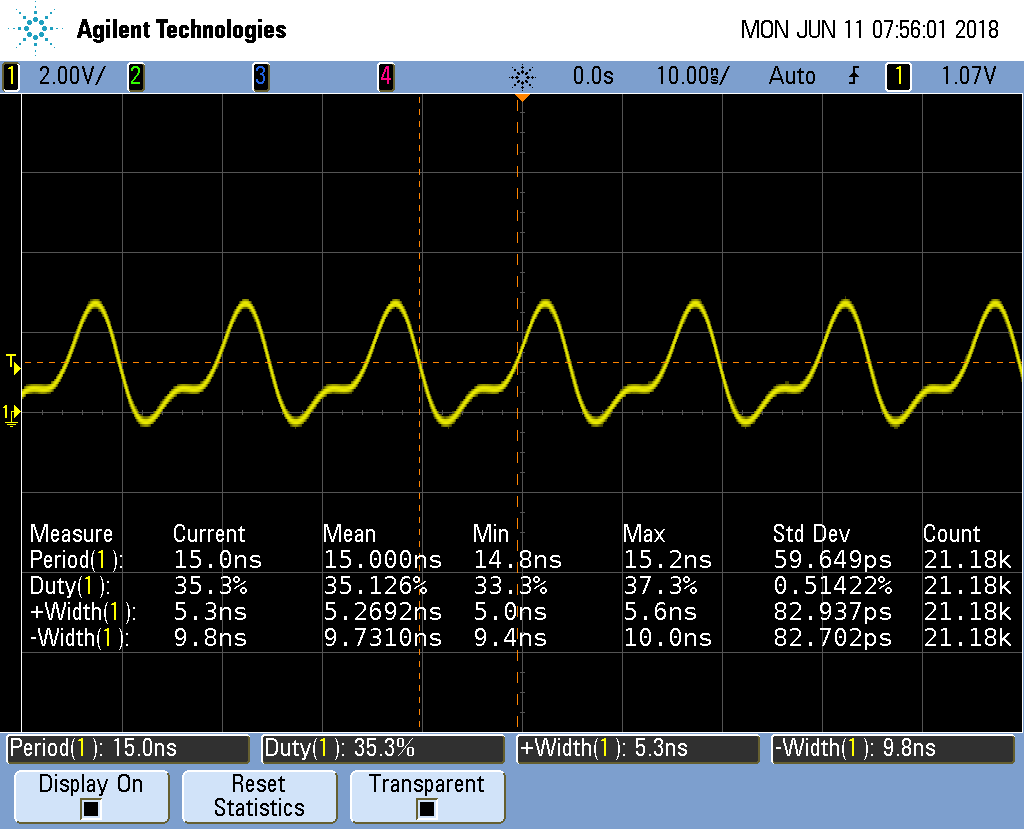
Fig. 503 Output of pwm1.pru0c with 0 delay cycles¶
Notice the period is 15ns which gives us a frequency of about 67MHz. At this high
frequency the breadboard that I’m using distorts the waveform so it’s no longer a squarewave.
The on time is 5.3ns and the off time is 9.8ns. That means __R30 |= gpio
took only one 5ns cycle and __R30 &= ~gpio also only took one cycle, but there
is also an extra cycle needed for the loop. This means the compiler was able to implement
the while loop in just three 5ns instructions! Not bad.
We want a square wave, so we need to add a delay to correct for the delay of looping back.
Here’s the code that does just that.
1#include <stdint.h>
2#include <pru_cfg.h>
3#include "resource_table_empty.h"
4#include "prugpio.h"
5
6volatile register uint32_t __R30;
7volatile register uint32_t __R31;
8
9void main(void)
10{
11 uint32_t gpio = P9_31; // Select which pin to toggle.;
12
13 /* Clear SYSCFG[STANDBY_INIT] to enable OCP master port */
14 CT_CFG.SYSCFG_bit.STANDBY_INIT = 0;
15
16 while (1) {
17 __R30 |= gpio; // Set the GPIO pin to 1
18 __delay_cycles(1); // Delay one cycle to correct for loop time
19 __R30 &= ~gpio; // Clear the GPIO pin
20 __delay_cycles(0);
21 }
22}
The output now looks like:
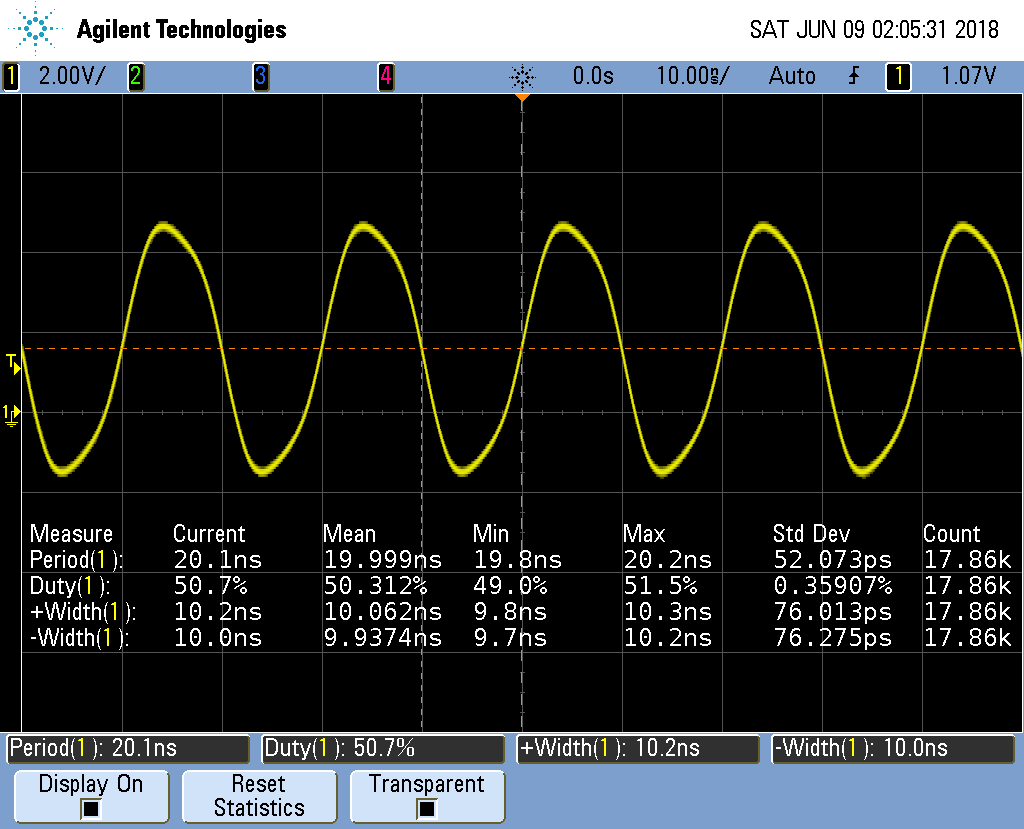
Fig. 504 Output of pwm2.pru0.c corrected delay¶
It’s not hard to adjust the two __delay_cycles
to get the desired frequency and duty cycle.
Controlling the PWM Frequency¶
Problem¶
You would like to control the frequency and duty cycle of the PWM without recompiling.
Solution¶
Have the PRU read the on and off times from a shared memory location. Each PRU has is own 8KB of data memory (DRAM) and 12KB of shared memory (SHAREDMEM) that the ARM processor can also access. See PRU Block Diagram.
The DRAM 0 address is 0x0000 for PRU 0. The same DRAM appears at address 0x4A300000 as seen from the ARM processor.
Tip
See page 184 of the AM335x TRM (184).
We take the previous PRU code and add the lines
#define PRU0_DRAM 0x00000 // Offset to DRAM
volatile unsigned int *pru0_dram = PRU0_DRAM;
to define a pointer to the DRAM.
Note
The volatile keyword is used here to tell the compiler the value this points to may change, so don’t make any assumptions while optimizing.
Later in the code we use
pru0_dram[ch] = on[ch]; // Copy to DRAM0 so the ARM can change it
pru0_dram[ch+MAXCH] = off[ch]; // Copy after the on array
to write the on and off times to the DRAM. Then inside the while loop we use
onCount[ch] = pru0_dram[2*ch]; // Read from DRAM0
offCount[ch]= pru0_dram[2*ch+1];
to read from the DRAM when resetting the counters. Now, while the PRU is running, the ARM can write values into the DRAM and change the PWM on and off times. pwm4.pru0.c is the whole code.
1// This code does MAXCH parallel PWM channels.
2// It's period is 3 us
3#include <stdint.h>
4#include <pru_cfg.h>
5#include "resource_table_empty.h"
6
7#define PRU0_DRAM 0x00000 // Offset to DRAM
8// Skip the first 0x200 byte of DRAM since the Makefile allocates
9// 0x100 for the STACK and 0x100 for the HEAP.
10volatile unsigned int *pru0_dram = (unsigned int *) (PRU0_DRAM + 0x200);
11
12#define MAXCH 4 // Maximum number of channels per PRU
13
14volatile register uint32_t __R30;
15volatile register uint32_t __R31;
16
17void main(void)
18{
19 uint32_t ch;
20 uint32_t on[] = {1, 2, 3, 4}; // Number of cycles to stay on
21 uint32_t off[] = {4, 3, 2, 1}; // Number to stay off
22 uint32_t onCount[MAXCH]; // Current count
23 uint32_t offCount[MAXCH];
24
25 /* Clear SYSCFG[STANDBY_INIT] to enable OCP master port */
26 CT_CFG.SYSCFG_bit.STANDBY_INIT = 0;
27
28 // Initialize the channel counters.
29 for(ch=0; ch<MAXCH; ch++) {
30 pru0_dram[2*ch ] = on[ch]; // Copy to DRAM0 so the ARM can change it
31 pru0_dram[2*ch+1] = off[ch]; // Interleave the on and off values
32 onCount[ch] = on[ch];
33 offCount[ch]= off[ch];
34 }
35
36 while (1) {
37 for(ch=0; ch<MAXCH; ch++) {
38 if(onCount[ch]) {
39 onCount[ch]--;
40 __R30 |= 0x1<<ch; // Set the GPIO pin to 1
41 } else if(offCount[ch]) {
42 offCount[ch]--;
43 __R30 &= ~(0x1<<ch); // Clear the GPIO pin
44 } else {
45 onCount[ch] = pru0_dram[2*ch]; // Read from DRAM0
46 offCount[ch]= pru0_dram[2*ch+1];
47 }
48 }
49 }
50}
Here is code that runs on the ARM side to set the on and off time values.
1/*
2 *
3 * pwm tester
4 * The on cycle and off cycles are stored in each PRU's Data memory
5 *
6 */
7
8#include <stdio.h>
9#include <fcntl.h>
10#include <sys/mman.h>
11
12#define MAXCH 4
13
14#define PRU_ADDR 0x4A300000 // Start of PRU memory Page 184 am335x TRM
15#define PRU_LEN 0x80000 // Length of PRU memory
16#define PRU0_DRAM 0x00000 // Offset to DRAM
17#define PRU1_DRAM 0x02000
18#define PRU_SHAREDMEM 0x10000 // Offset to shared memory
19
20unsigned int *pru0DRAM_32int_ptr; // Points to the start of local DRAM
21unsigned int *pru1DRAM_32int_ptr; // Points to the start of local DRAM
22unsigned int *prusharedMem_32int_ptr; // Points to the start of the shared memory
23
24/*******************************************************************************
25* int start_pwm_count(int ch, int countOn, int countOff)
26*
27* Starts a pwm pulse on for countOn and off for countOff to a single channel (ch)
28*******************************************************************************/
29int start_pwm_count(int ch, int countOn, int countOff) {
30 unsigned int *pruDRAM_32int_ptr = pru0DRAM_32int_ptr;
31
32 printf("countOn: %d, countOff: %d, count: %d\n",
33 countOn, countOff, countOn+countOff);
34 // write to PRU shared memory
35 pruDRAM_32int_ptr[2*(ch)+0] = countOn; // On time
36 pruDRAM_32int_ptr[2*(ch)+1] = countOff; // Off time
37 return 0;
38}
39
40int main(int argc, char *argv[])
41{
42 unsigned int *pru; // Points to start of PRU memory.
43 int fd;
44 printf("Servo tester\n");
45
46 fd = open ("/dev/mem", O_RDWR | O_SYNC);
47 if (fd == -1) {
48 printf ("ERROR: could not open /dev/mem.\n\n");
49 return 1;
50 }
51 pru = mmap (0, PRU_LEN, PROT_READ | PROT_WRITE, MAP_SHARED, fd, PRU_ADDR);
52 if (pru == MAP_FAILED) {
53 printf ("ERROR: could not map memory.\n\n");
54 return 1;
55 }
56 close(fd);
57 printf ("Using /dev/mem.\n");
58
59 pru0DRAM_32int_ptr = pru + PRU0_DRAM/4 + 0x200/4; // Points to 0x200 of PRU0 memory
60 pru1DRAM_32int_ptr = pru + PRU1_DRAM/4 + 0x200/4; // Points to 0x200 of PRU1 memory
61 prusharedMem_32int_ptr = pru + PRU_SHAREDMEM/4; // Points to start of shared memory
62
63 int i;
64 for(i=0; i<MAXCH; i++) {
65 start_pwm_count(i, i+1, 20-(i+1));
66 }
67
68 if(munmap(pru, PRU_LEN)) {
69 printf("munmap failed\n");
70 } else {
71 printf("munmap succeeded\n");
72 }
73}
A quick check on the ‘scope shows Four Channel PWM with ARM control.

Fig. 505 Four Channel PWM with ARM control¶
From the ‘scope you see a 1 cycle on time results in a 450ns wide pulse and a 3.06us period is 326KHz, much slower than the 10ns pulse we saw before. But it may be more than fast enough for many applications. For example, most servos run at 50Hz.
But we can do better.
Loop Unrolling for Better Performance¶
Problem¶
The ARM controlled PRU code runs too slowly.
Solution¶
Simple loop unrolling can greatly improve the speed. pwm5.pru0.c is our unrolled version.
1// This code does MAXCH parallel PWM channels.
2// It's period is 510ns.
3#include <stdint.h>
4#include <pru_cfg.h>
5#include "resource_table_empty.h"
6
7#define PRU0_DRAM 0x00000 // Offset to DRAM
8// Skip the first 0x200 byte of DRAM since the Makefile allocates
9// 0x100 for the STACK and 0x100 for the HEAP.
10volatile unsigned int *pru0_dram = (unsigned int *) (PRU0_DRAM + 0x200);
11
12#define MAXCH 4 // Maximum number of channels per PRU
13
14#define update(ch) \
15 if(onCount[ch]) { \
16 onCount[ch]--; \
17 __R30 |= 0x1<<ch; \
18 } else if(offCount[ch]) { \
19 offCount[ch]--; \
20 __R30 &= ~(0x1<<ch); \
21 } else { \
22 onCount[ch] = pru0_dram[2*ch]; \
23 offCount[ch]= pru0_dram[2*ch+1]; \
24 }
25
26volatile register uint32_t __R30;
27volatile register uint32_t __R31;
28
29void main(void)
30{
31 uint32_t ch;
32 uint32_t on[] = {1, 2, 3, 4};
33 uint32_t off[] = {4, 3, 2, 1};
34 uint32_t onCount[MAXCH], offCount[MAXCH];
35
36 /* Clear SYSCFG[STANDBY_INIT] to enable OCP master port */
37 CT_CFG.SYSCFG_bit.STANDBY_INIT = 0;
38
39#pragma UNROLL(MAXCH)
40 for(ch=0; ch<MAXCH; ch++) {
41 pru0_dram[2*ch ] = on[ch]; // Copy to DRAM0 so the ARM can change it
42 pru0_dram[2*ch+1] = off[ch]; // Interleave the on and off values
43 onCount[ch] = on[ch];
44 offCount[ch]= off[ch];
45 }
46
47 while (1) {
48 update(0)
49 update(1)
50 update(2)
51 update(3)
52 }
53}
The output of pwm5.pru0.c is in the figure below.
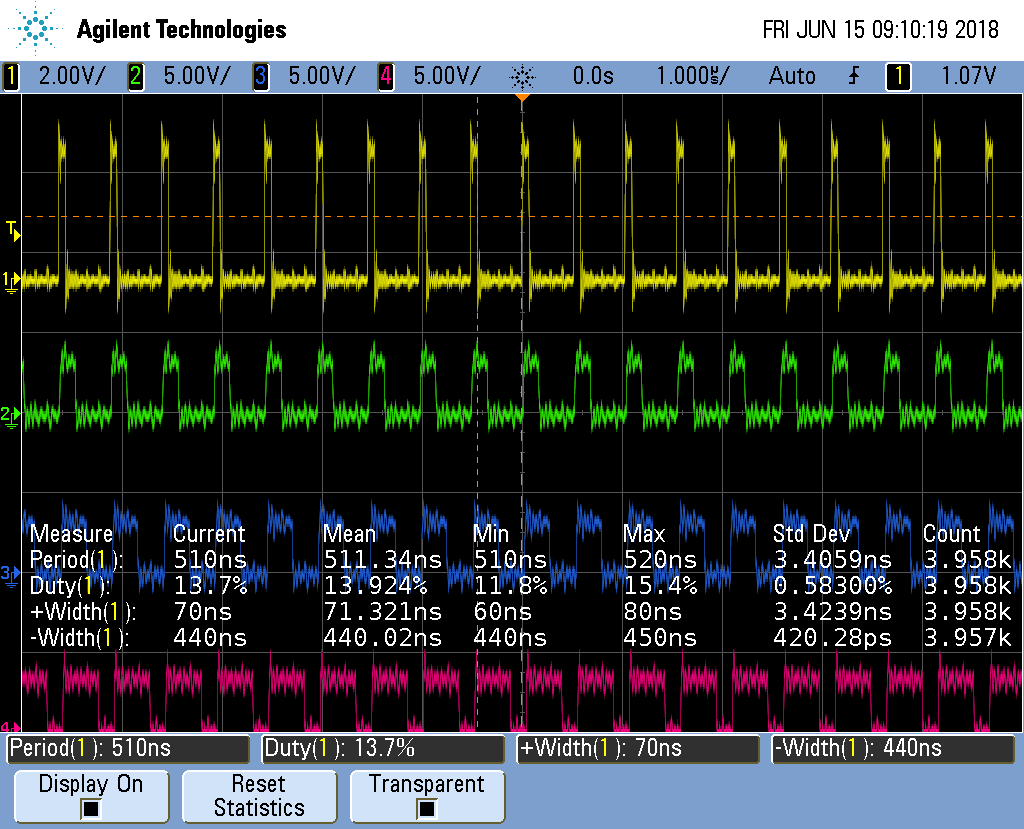
Fig. 506 pwm5.pru0.c Unrolled version of pwm4.pru0.c¶
It’s running about 6 times faster than pwm4.pru0.c.
Measure |
pwm4.pru0.c time |
pwm5.pru0.c time |
Speedup |
pwm5.pru0.c w/o UNROLL |
Speedup |
Period |
3.06μs |
510ns |
6x |
1.81μs |
~1.7x |
Width+ |
450ns |
70ns |
~6x |
1.56μs |
~.3x |
Not a bad speed up for just a couple of simple changes.
Discussion¶
Here’s how it works.
First look at line 39. You see #pragma UNROLL(MAXCH) which is a pragma
that tells the compiler to unroll the loop that follows. We are unrolling it
MAXCH times (four times in this example). Just removing the pragma causes
the speedup compared to the pwm4.pru0.c case to drop from 6x to only 1.7x.
We also have our for loop inside the while loop that can be unrolled.
Unfortunately UNROLL() doesn’t work on it, therefore we have to do it by
hand. We could take the loop and just copy it three times, but that would
make it harder to maintain the code. Instead I converted the loop into a
#define (lines 14-24) and invoked update() as needed (lines 48-51).
This is not a function call. Whenever the preprocessor sees the update()
it copies the code an then it’s compiled.
This unrolling gets us an impressive 6x speedup.
Making All the Pulses Start at the Same Time¶
Problem¶
I have a mutlichannel PWM working, but the pulses aren’t synchronized, that is they don’t all start at the same time.
Solution¶
pwm5.pru0 Zoomed In is a zoomed in version of the previous figure. Notice the pulse in each channel starts about 15ns later than the channel above it.

Fig. 507 pwm5.pru0 Zoomed In¶
The solution is to declare Rtmp (line 35) which holds the value for __R30.
1// This code does MAXCH parallel PWM channels.
2// All channels start at the same time. It's period is 510ns
3#include <stdint.h>
4#include <pru_cfg.h>
5#include "resource_table_empty.h"
6
7#define PRU0_DRAM 0x00000 // Offset to DRAM
8// Skip the first 0x200 byte of DRAM since the Makefile allocates
9// 0x100 for the STACK and 0x100 for the HEAP.
10volatile unsigned int *pru0_dram = (unsigned int *) (PRU0_DRAM + 0x200);
11
12#define MAXCH 4 // Maximum number of channels per PRU
13
14#define update(ch) \
15 if(onCount[ch]) { \
16 onCount[ch]--; \
17 Rtmp |= 0x1<<ch; \
18 } else if(offCount[ch]) { \
19 offCount[ch]--; \
20 Rtmp &= ~(0x1<<ch); \
21 } else { \
22 onCount[ch] = pru0_dram[2*ch]; \
23 offCount[ch]= pru0_dram[2*ch+1]; \
24 }
25
26volatile register uint32_t __R30;
27volatile register uint32_t __R31;
28
29void main(void)
30{
31 uint32_t ch;
32 uint32_t on[] = {1, 2, 3, 4};
33 uint32_t off[] = {4, 3, 2, 1};
34 uint32_t onCount[MAXCH], offCount[MAXCH];
35 register uint32_t Rtmp;
36
37 /* Clear SYSCFG[STANDBY_INIT] to enable OCP master port */
38 CT_CFG.SYSCFG_bit.STANDBY_INIT = 0;
39
40#pragma UNROLL(MAXCH)
41 for(ch=0; ch<MAXCH; ch++) {
42 pru0_dram[2*ch ] = on[ch]; // Copy to DRAM0 so the ARM can change it
43 pru0_dram[2*ch+1] = off[ch]; // Interleave the on and off values
44 onCount[ch] = on[ch];
45 offCount[ch]= off[ch];
46 }
47 Rtmp = __R30;
48
49 while (1) {
50 update(0)
51 update(1)
52 update(2)
53 update(3)
54 __R30 = Rtmp;
55 }
56}
pwm6.pru0.c Sync'ed Version of pwm5.pru0.c
Each channel writes it’s value to Rtmp (lines 17 and 20) and then after
each channel has updated, Rtmp is copied to __R30 (line 54).
Discussion¶
The following figure shows the channel are sync’ed. Though the period is slightly longer than before.
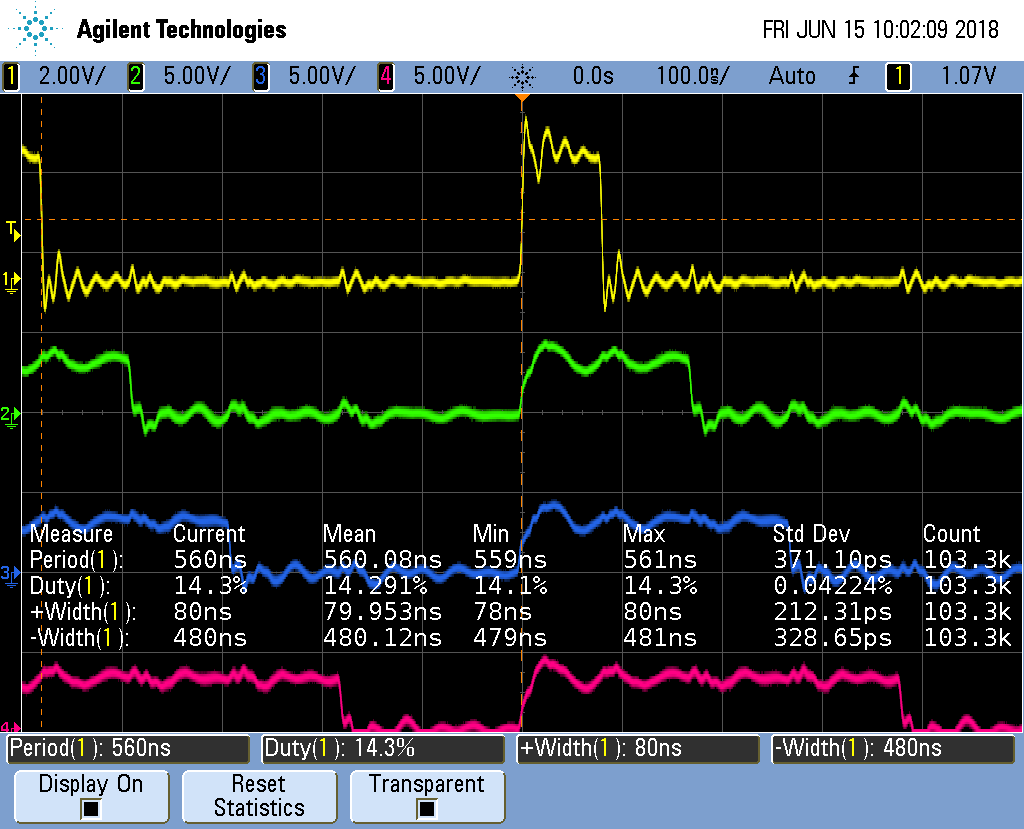
Fig. 508 pwm6.pru0 Synchronized Channels¶
Adding More Channels via PRU 1¶
Problem¶
You need more output channels, or you need to shorten the period.
Solution¶
PRU 0 can output up to eight output pins (see Mapping bit positions to pin names). The code presented so far can be easily extended to use the eight output pins.
But what if you need more channels? You can always use PRU1, it has 14 output pins.
Or, what if four channels is enough, but you need a shorter period. Everytime you add a channel, the overall period gets longer. Twice as many channels means twice as long a period. If you move half the channels to PRU 1, you will make the period half as long.
Here’s the code (pwm7.pru0.c)
1// This code does MAXCH parallel PWM channels on both PRU 0 and PRU 1
2// All channels start at the same time. But the PRU 1 ch have a difference period
3// It's period is 370ns
4#include <stdint.h>
5#include <pru_cfg.h>
6#include "resource_table_empty.h"
7
8#define PRUNUM 0
9
10#define PRU0_DRAM 0x00000 // Offset to DRAM
11// Skip the first 0x200 byte of DRAM since the Makefile allocates
12// 0x100 for the STACK and 0x100 for the HEAP.
13volatile unsigned int *pru0_dram = (unsigned int *) (PRU0_DRAM + 0x200);
14
15#define MAXCH 2 // Maximum number of channels per PRU
16
17#define update(ch) \
18 if(onCount[ch]) { \
19 onCount[ch]--; \
20 Rtmp |= 0x1<<ch; \
21 } else if(offCount[ch]) { \
22 offCount[ch]--; \
23 Rtmp &= ~(0x1<<ch); \
24 } else { \
25 onCount[ch] = pru0_dram[2*ch]; \
26 offCount[ch]= pru0_dram[2*ch+1]; \
27 }
28
29volatile register uint32_t __R30;
30volatile register uint32_t __R31;
31
32void main(void)
33{
34 uint32_t ch;
35 uint32_t on[] = {1, 2, 3, 4};
36 uint32_t off[] = {4, 3, 2, 1};
37 uint32_t onCount[MAXCH], offCount[MAXCH];
38 register uint32_t Rtmp;
39
40 /* Clear SYSCFG[STANDBY_INIT] to enable OCP master port */
41 CT_CFG.SYSCFG_bit.STANDBY_INIT = 0;
42
43#pragma UNROLL(MAXCH)
44 for(ch=0; ch<MAXCH; ch++) {
45 pru0_dram[2*ch ] = on [ch+PRUNUM*MAXCH]; // Copy to DRAM0 so the ARM can change it
46 pru0_dram[2*ch+1] = off[ch+PRUNUM*MAXCH]; // Interleave the on and off values
47 onCount[ch] = on [ch+PRUNUM*MAXCH];
48 offCount[ch]= off[ch+PRUNUM*MAXCH];
49 }
50 Rtmp = __R30;
51
52 while (1) {
53 update(0)
54 update(1)
55 __R30 = Rtmp;
56 }
57}
Be sure to run pwm7_setup.sh to get the correct pins configured.
1#!/bin/bash
2#
3export TARGET=pwm7.pru0
4echo TARGET=$TARGET
5
6# Configure the PRU pins based on which Beagle is running
7machine=$(awk '{print $NF}' /proc/device-tree/model)
8echo -n $machine
9if [ $machine = "Black" ]; then
10 echo " Found"
11 pins="P9_31 P9_29 P8_45 P8_46"
12elif [ $machine = "Blue" ]; then
13 echo " Found"
14 pins=""
15elif [ $machine = "PocketBeagle" ]; then
16 echo " Found"
17 pins="P1_36 P1_33"
18else
19 echo " Not Found"
20 pins=""
21fi
22
23for pin in $pins
24do
25 echo $pin
26 config-pin $pin pruout
27 config-pin -q $pin
28done
This makes sure the PRU 1 pins are properly configured.
Here we have a second pwm7 file. pwm7.pru1.c is identical to pwm7.pru0.c
except PRUNUM is set to 1, instead of 0.
Compile and run the two files with:
bone$ *make TARGET=pwm7.pru0; make TARGET=pwm7.pru1*
/opt/source/pru-cookbook-code/common/Makefile:29: MODEL=TI_AM335x_BeagleBone_Black,TARGET=pwm7.pru0
- Stopping PRU 0
- copying firmware file /tmp/vsx-examples/pwm7.pru0.out to /lib/firmware/am335x-pru0-fw
write_init_pins.sh
- Starting PRU 0
MODEL = TI_AM335x_BeagleBone_Black
PROC = pru
PRUN = 0
PRU_DIR = /sys/class/remoteproc/remoteproc1
/opt/source/pru-cookbook-code/common/Makefile:29: MODEL=TI_AM335x_BeagleBone_Black,TARGET=pwm7.pru1
- Stopping PRU 1
- copying firmware file /tmp/vsx-examples/pwm7.pru1.out to /lib/firmware/am335x-pru1-fw
write_init_pins.sh
- Starting PRU 1
MODEL = TI_AM335x_BeagleBone_Black
PROC = pru
PRUN = 1
PRU_DIR = /sys/class/remoteproc/remoteproc2
This will first stop, compile and start PRU 0, then do the same for PRU 1.
Moving half of the channels to PRU1 dropped the period from 510ns to 370ns, so we gained a bit.
Discussion¶
There weren’t many changes to be made. Line 15 we set MAXCH to 2. Lines 44-48 is where the big change is.
pru0_dram[2*ch ] = on [ch+PRUNUN*MAXCH]; // Copy to DRAM0 so the ARM can change it
pru0_dram[2*ch+1] = off[ch+PRUNUN*MAXCH]; // Interleave the on and off values
onCount[ch] = on [ch+PRUNUN*MAXCH];
offCount[ch]= off[ch+PRUNUN*MAXCH];
If we are compiling for PRU 0, on[ch+PRUNUN*MAXCH] becomes on[ch+0*2] which is
on[ch] which is what we had before. But now if we are on PRU 1 it becomes
on[ch+1*2] which is on[ch+2]. That means we are picking up the second
half of the on and off arrays. The first half goes to PRU 0, the second to
PRU 1. So the same code can be used for both PRUs, but we get slightly different
behavior.
Running the code you will see the next figure.
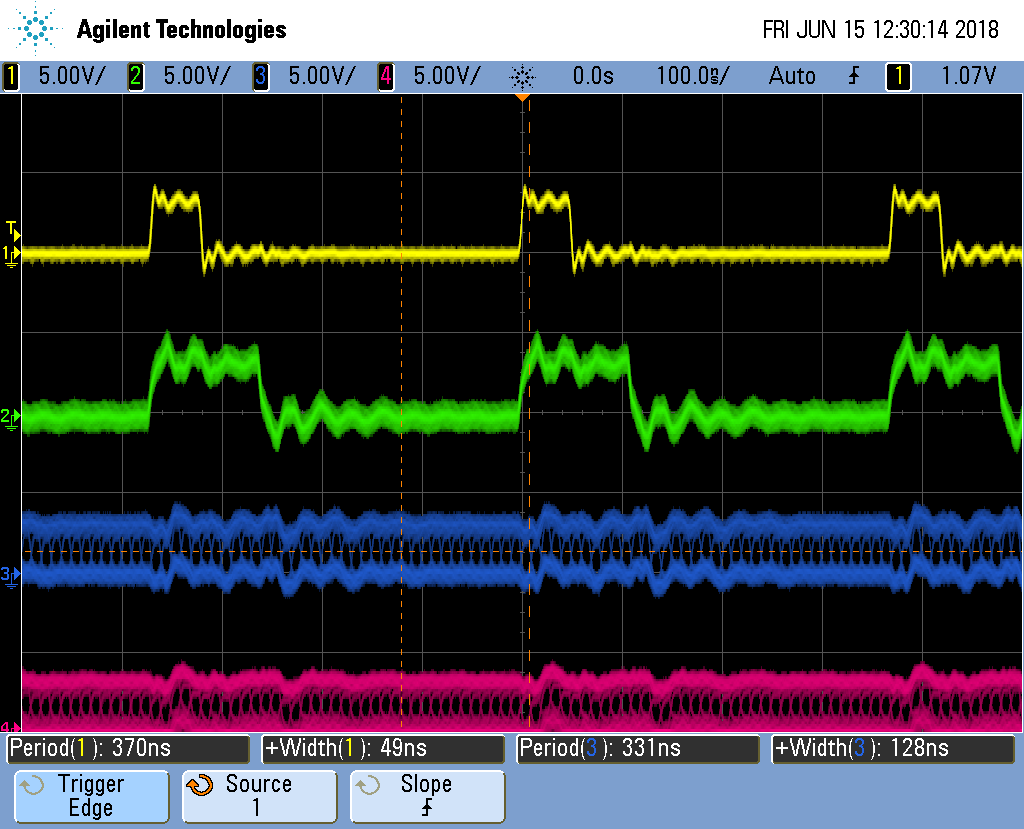
Fig. 509 pwm7.pru0 Two PRUs running¶
What’s going on there, the first channels look fine, but the PRU 1 channels are blurred. To see what’s happening, let’s stop the oscilloscope.
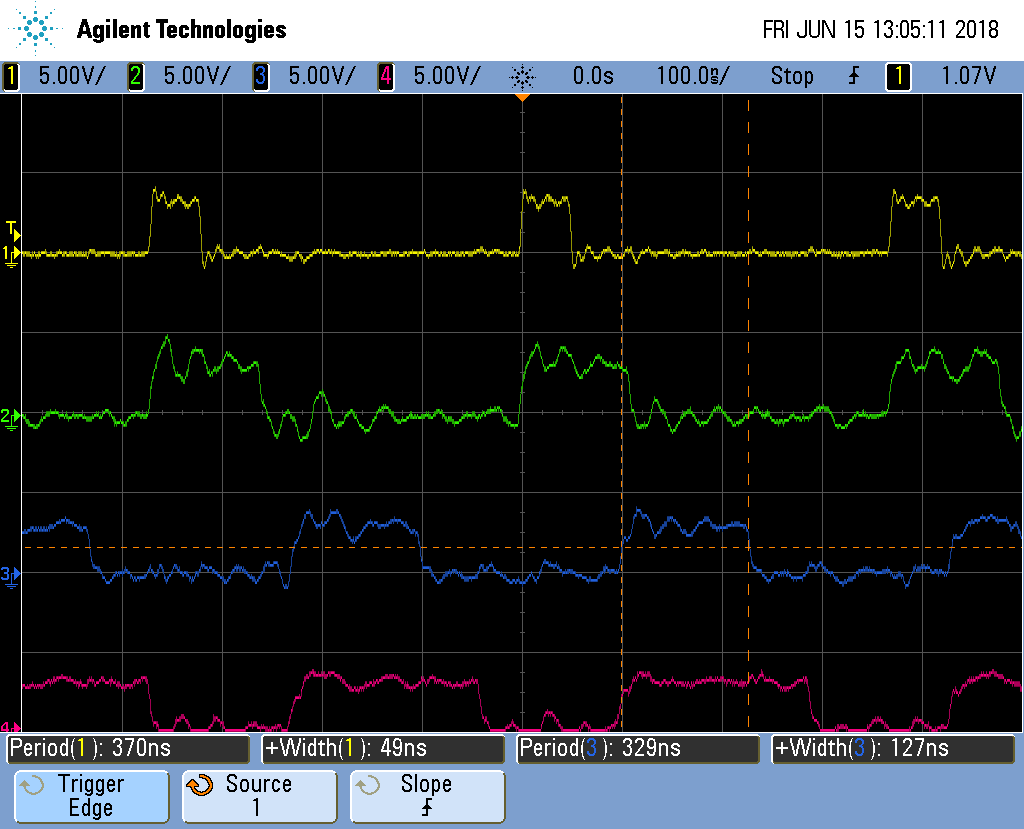
Fig. 510 pwm7.pru0 Two PRUs stopped¶
The stopped display shows that the four channels are doing what we wanted, except The PRU 0 channels have a period of 370ns while the PRU 1 channels at 330ns. It appears the compiler has optimied the two PRUs slightly differently.
Synchronizing Two PRUs¶
Problem¶
I need to synchronize the two PRUs so they run together.
Solution¶
Use the Interrupt Controller (INTC). It allows one PRU to signal the other.
Page 225 of the AM335x TRM 225
has details of how it works. Here’s the code for PRU 0, which at the end of the
while loop signals PRU 1 to start(pwm8.pru0.c).
1// This code does MAXCH parallel PWM channels on both PRU 0 and PRU 1
2// All channels start at the same time.
3// It's period is 430ns
4#include <stdint.h>
5#include <pru_cfg.h>
6#include <pru_intc.h>
7#include <pru_ctrl.h>
8#include "resource_table_empty.h"
9
10#define PRUNUM 0
11
12#define PRU0_DRAM 0x00000 // Offset to DRAM
13// Skip the first 0x200 byte of DRAM since the Makefile allocates
14// 0x100 for the STACK and 0x100 for the HEAP.
15volatile unsigned int *pru0_dram = (unsigned int *) (PRU0_DRAM + 0x200);
16
17#define MAXCH 2 // Maximum number of channels per PRU
18
19#define update(ch) \
20 if(onCount[ch]) { \
21 onCount[ch]--; \
22 Rtmp |= 0x1<<ch; \
23 } else if(offCount[ch]) { \
24 offCount[ch]--; \
25 Rtmp &= ~(0x1<<ch); \
26 } else { \
27 onCount[ch] = pru0_dram[2*ch]; \
28 offCount[ch]= pru0_dram[2*ch+1]; \
29 }
30
31volatile register uint32_t __R30;
32volatile register uint32_t __R31;
33
34// Initialize interrupts so the PRUs can be syncronized.
35// PRU1 is started first and then waits for PRU0
36// PRU0 is then started and tells PRU1 when to start going
37void configIntc(void) {
38 __R31 = 0x00000000; // Clear any pending PRU-generated events
39 CT_INTC.CMR4_bit.CH_MAP_16 = 1; // Map event 16 to channel 1
40 CT_INTC.HMR0_bit.HINT_MAP_1 = 1; // Map channel 1 to host 1
41 CT_INTC.SICR = 16; // Ensure event 16 is cleared
42 CT_INTC.EISR = 16; // Enable event 16
43 CT_INTC.HIEISR |= (1 << 0); // Enable Host interrupt 1
44 CT_INTC.GER = 1; // Globally enable host interrupts
45}
46
47void main(void)
48{
49 uint32_t ch;
50 uint32_t on[] = {1, 2, 3, 4};
51 uint32_t off[] = {4, 3, 2, 1};
52 uint32_t onCount[MAXCH], offCount[MAXCH];
53 register uint32_t Rtmp;
54
55 CT_CFG.GPCFG0 = 0x0000; // Configure GPI and GPO as Mode 0 (Direct Connect)
56 configIntc(); // Configure INTC
57
58 /* Clear SYSCFG[STANDBY_INIT] to enable OCP master port */
59 CT_CFG.SYSCFG_bit.STANDBY_INIT = 0;
60
61#pragma UNROLL(MAXCH)
62 for(ch=0; ch<MAXCH; ch++) {
63 pru0_dram[2*ch ] = on [ch+PRUNUM*MAXCH]; // Copy to DRAM0 so the ARM can change it
64 pru0_dram[2*ch+1] = off[ch+PRUNUM*MAXCH]; // Interleave the on and off values
65 onCount[ch] = on [ch+PRUNUM*MAXCH];
66 offCount[ch]= off[ch+PRUNUM*MAXCH];
67 }
68 Rtmp = __R30;
69
70 while (1) {
71 __R30 = Rtmp;
72 update(0)
73 update(1)
74#define PRU0_PRU1_EVT 16
75 __R31 = (PRU0_PRU1_EVT-16) | (0x1<<5); //Tell PRU 1 to start
76 __delay_cycles(1);
77 }
78}
pwm8.pru0.c PRU 0 using INTC to send a signal to PRU 1
PRU 2’s code waits for PRU 0 before going.
1// This code does MAXCH parallel PWM channels on both PRU 0 and PRU 1
2// All channels start at the same time.
3// It's period is 430ns
4#include <stdint.h>
5#include <pru_cfg.h>
6#include <pru_intc.h>
7#include <pru_ctrl.h>
8#include "resource_table_empty.h"
9
10#define PRUNUM 1
11
12#define PRU0_DRAM 0x00000 // Offset to DRAM
13// Skip the first 0x200 byte of DRAM since the Makefile allocates
14// 0x100 for the STACK and 0x100 for the HEAP.
15volatile unsigned int *pru0_dram = (unsigned int *) (PRU0_DRAM + 0x200);
16
17#define MAXCH 2 // Maximum number of channels per PRU
18
19#define update(ch) \
20 if(onCount[ch]) { \
21 onCount[ch]--; \
22 Rtmp |= 0x1<<ch; \
23 } else if(offCount[ch]) { \
24 offCount[ch]--; \
25 Rtmp &= ~(0x1<<ch); \
26 } else { \
27 onCount[ch] = pru0_dram[2*ch]; \
28 offCount[ch]= pru0_dram[2*ch+1]; \
29 }
30
31volatile register uint32_t __R30;
32volatile register uint32_t __R31;
33
34// Initialize interrupts so the PRUs can be syncronized.
35// PRU1 is started first and then waits for PRU0
36// PRU0 is then started and tells PRU1 when to start going
37
38void main(void)
39{
40 uint32_t ch;
41 uint32_t on[] = {1, 2, 3, 4};
42 uint32_t off[] = {4, 3, 2, 1};
43 uint32_t onCount[MAXCH], offCount[MAXCH];
44 register uint32_t Rtmp;
45
46 /* Clear SYSCFG[STANDBY_INIT] to enable OCP master port */
47 CT_CFG.SYSCFG_bit.STANDBY_INIT = 0;
48
49#pragma UNROLL(MAXCH)
50 for(ch=0; ch<MAXCH; ch++) {
51 pru0_dram[2*ch ] = on [ch+PRUNUM*MAXCH]; // Copy to DRAM0 so the ARM can change it
52 pru0_dram[2*ch+1] = off[ch+PRUNUM*MAXCH]; // Interleave the on and off values
53 onCount[ch] = on [ch+PRUNUM*MAXCH];
54 offCount[ch]= off[ch+PRUNUM*MAXCH];
55 }
56 Rtmp = __R30;
57
58 while (1) {
59 while((__R31 & (0x1<<31))==0) { // Wait for PRU 0
60 }
61 CT_INTC.SICR = 16; // Clear event 16
62 __R30 = Rtmp;
63 update(0)
64 update(1)
65 }
66}
pwm8.pru1.c PRU 1 waiting for INTC from PRU 0
In pwm8.pru0.c PRU 1 waits for a signal from PRU 0, so be sure to start PRU 1 first.
bone$ *make TARGET=pwm8.pru0; make TARGET=pwm8.pru1*
Discussion¶
The figure below shows the two PRUs are synchronized, though there is some extra overhead in the process so the period is longer.
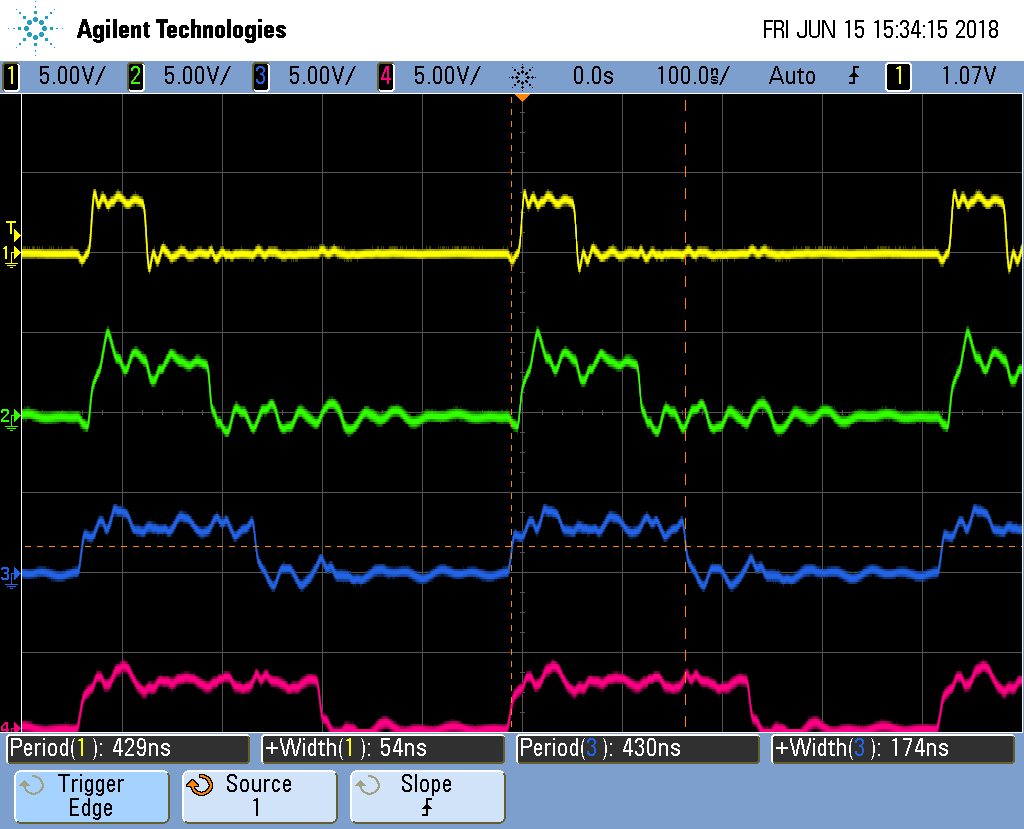
Fig. 511 pwm8.pru0 PRUs synced¶
This isn’t much different from the previous examples.
PRU |
Line |
Change |
|---|---|---|
0 |
37-45 |
For PRU 0 these define |
0 |
55-56 |
Set a configuration register and call configInitc. |
1 |
59-61 |
PRU 1 then waits for PRU 0 to signal it. Bit 31 of |
0 |
74-75 |
On PRU 0 this generates the interrupt to send to PRU 1. I found PRU 1 was slow to respond to the interrupt, so I put this code at the end of the loop to give time for the signal to get to PRU 1. |
This ends the multipart pwm example.
Reading an Input at Regular Intervals¶
Problem¶
You have an input pin that needs to be read at regular intervals.
Solution¶
You can use the __R31 register to read an input pin. Let’s use the following pins.
Direction |
Bit number |
Black |
AI (ICSS2) |
|
|---|---|---|---|---|
out |
0 |
P9_31 |
P8_44 |
P1.36 |
in |
7 |
P9_25 |
P8_36 |
P1.29 |
These values came from Mapping bit positions to pin names.
Configure the pins with input_setup.sh.
1#!/bin/bash
2#
3export TARGET=input.pru0
4echo TARGET=$TARGET
5
6# Configure the PRU pins based on which Beagle is running
7machine=$(awk '{print $NF}' /proc/device-tree/model)
8echo -n $machine
9if [ $machine = "Black" ]; then
10 echo " Found"
11 config-pin P9_31 pruout
12 config-pin -q P9_31
13 config-pin P9_25 pruin
14 config-pin -q P9_25
15elif [ $machine = "Blue" ]; then
16 echo " Found"
17 pins=""
18elif [ $machine = "PocketBeagle" ]; then
19 echo " Found"
20 config-pin P1_36 pruout
21 config-pin -q P1_36
22 config-pin P1_29 pruin
23 config-pin -q P1_29
24else
25 echo " Not Found"
26 pins=""
27fi
The following code reads the input pin and writes its value to the output pin.
1#include <stdint.h>
2#include <pru_cfg.h>
3#include "resource_table_empty.h"
4
5volatile register uint32_t __R30;
6volatile register uint32_t __R31;
7
8void main(void)
9{
10 uint32_t led;
11 uint32_t sw;
12
13 /* Clear SYSCFG[STANDBY_INIT] to enable OCP master port */
14 CT_CFG.SYSCFG_bit.STANDBY_INIT = 0;
15
16 led = 0x1<<0; // P9_31 or P1_36
17 sw = 0x1<<7; // P9_25 or P1_29
18
19 while (1) {
20 if((__R31&sw) == sw) {
21 __R30 |= led; // Turn on LED
22 } else
23 __R30 &= ~led; // Turn off LED
24 }
25}
26
Discussion¶
Just remember that __R30 is for outputs and __R31 is for inputs.
Analog Wave Generator¶
Problem¶
I want to generate an analog output, but only have GPIO pins.
Solution¶
The Beagle doesn’t have a built-in analog to digital converter. You could get a USB Audio Dongle which are under $10. But here we’ll take another approach.
Earlier we generated a PWM signal. Here we’ll generate a PWM whose duty cycle changes with time. A small duty cycle for when the output signal is small and a large duty cycle for when it is large.
This example was inspired by A PRU Sin Wave Generator in chapter 13 of Exploring BeagleBone by Derek Molloy.
Here’s the code.
1// Generate an analog waveform and use a filter to reconstruct it.
2#include <stdint.h>
3#include <pru_cfg.h>
4#include "resource_table_empty.h"
5#include <math.h>
6
7#define MAXT 100 // Maximum number of time samples
8#define SAWTOOTH // Pick which waveform
9
10volatile register uint32_t __R30;
11volatile register uint32_t __R31;
12
13void main(void)
14{
15 uint32_t onCount; // Current count for 1 out
16 uint32_t offCount; // count for 0 out
17 uint32_t i;
18 uint32_t waveform[MAXT]; // Waveform to be produced
19
20 // Generate a periodic wave in an array of MAXT values
21#ifdef SAWTOOTH
22 for(i=0; i<MAXT; i++) {
23 waveform[i] = i*100/MAXT;
24 }
25#endif
26#ifdef TRIANGLE
27 for(i=0; i<MAXT/2; i++) {
28 waveform[i] = 2*i*100/MAXT;
29 waveform[MAXT-i-1] = 2*i*100/MAXT;
30 }
31#endif
32#ifdef SINE
33 float gain = 50.0f;
34 float bias = 50.0f;
35 float freq = 2.0f * 3.14159f / MAXT;
36 for (i=0; i<MAXT; i++){
37 waveform[i] = (uint32_t)(bias+gain*sin(i*freq));
38 }
39#endif
40
41 /* Clear SYSCFG[STANDBY_INIT] to enable OCP master port */
42 CT_CFG.SYSCFG_bit.STANDBY_INIT = 0;
43
44 while (1) {
45 // Generate a PWM signal whose duty cycle matches
46 // the amplitude of the signal.
47 for(i=0; i<MAXT; i++) {
48 onCount = waveform[i];
49 offCount = 100 - onCount;
50 while(onCount--) {
51 __R30 |= 0x1; // Set the GPIO pin to 1
52 }
53 while(offCount--) {
54 __R30 &= ~(0x1); // Clear the GPIO pin
55 }
56 }
57 }
58}
Set the #define at line 7 to the number of samples in one cycle of the waveform
and set the #define at line 8 to which waveform and then run make.
Discussion¶
The code has two parts. The first part (lines 21 to 39) generate the waveform
to be output. The #define``s let you select which waveform you want to
generate. Since the output is a percent duty cycle, the values in ``waveform[]
must be between 0 and 100 inclusive. The waveform is only generated once, so
this part of the code isn’t time critical.
The second part (lines 44 to 54) uses the generated data to set the duty cycle of the PWM on a cycle-by-cycle basis. This part is time critical; the faster we can output the values, the higher the frequency of the output signal.
Suppose you want to generate a sawtooth waveform like the one shown in Continuous Sawtooth Waveform.
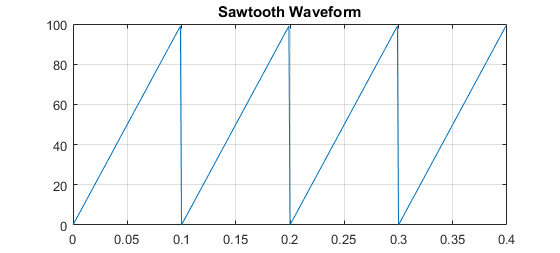
Fig. 512 Continuous Sawtooth Waveform¶
You need to sample the waveform and store one cycle. Sampled Sawtooth Waveform
shows a sampled version of the sawtooth. You need to generate MAXT samples;
here we show 20 samples, which may be enough. In the code MAXT is set to 100.
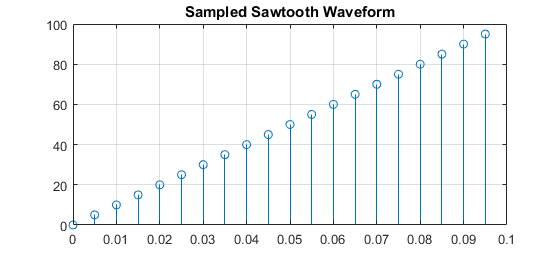
Fig. 513 Sampled Sawtooth Waveform¶
There’s a lot going on here; let’s take it line by line.
Line |
Explanation |
|---|---|
2-5 |
Standard c-header includes |
7 |
Number for samples in one cycle of the analog waveform |
8 |
Which waveform to use. We’ve defined SAWTOOTH, TRIANGLE and SINE, but you can define your own too. |
10-11 |
Declaring registers |
15-16 |
|
18 |
|
21-24 |
|
26-31 |
|
32-39 |
|
47 |
Here the |
48,49 |
|
50-52 |
Stay on for |
53-55 |
Now turn off for |
Unfiltered Sawtooth Waveform shows the output of the code.
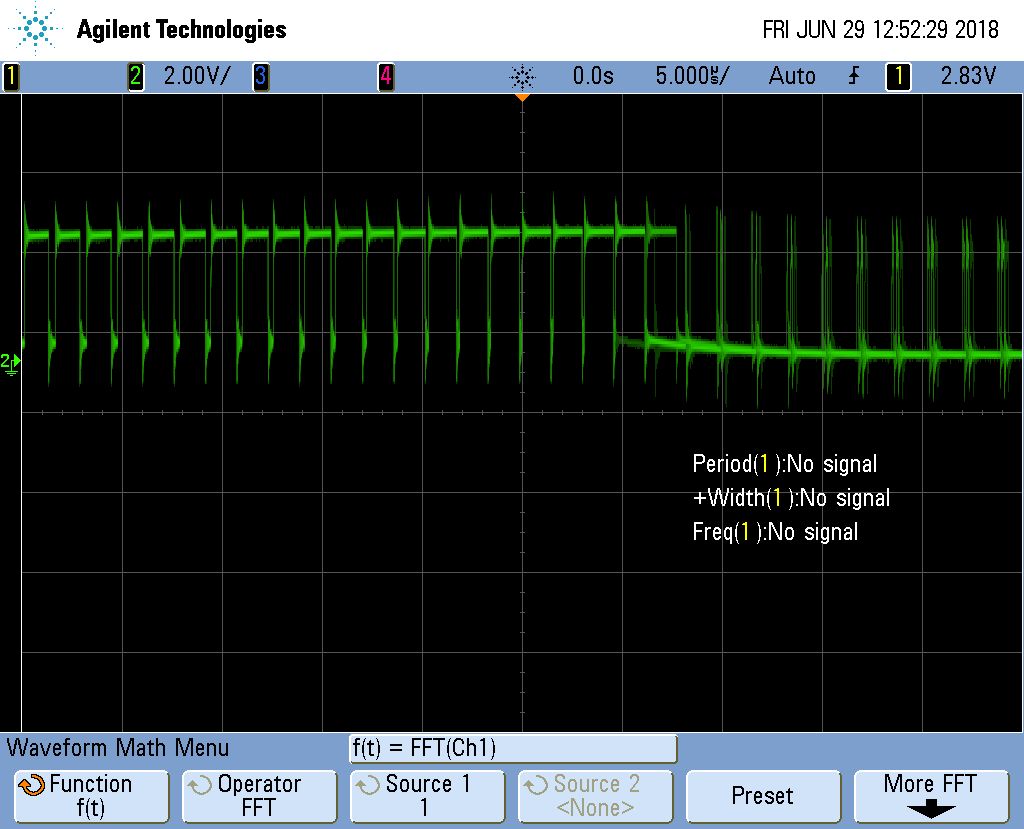
Fig. 514 Unfiltered Sawtooth Waveform¶
It doesn’t look like a sawtooth; but if you look at the left side you will see each cycle has a longer and longer on time. The duty cycle is increasing. Once it’s almost 100% duty cycle, it switches to a very small duty cycle. Therefore it’s output what we programmed, but what we want is the average of the signal. The left hand side has a large (and increasing) average which would be for top of the sawtooth. The right hand side has a small average, which is what you want for the start of the sawtooth.
A simple low-pass filter, built with one resistor and one capacitor will do it. Low-Pass Filter Wiring Diagram shows how to wire it up.
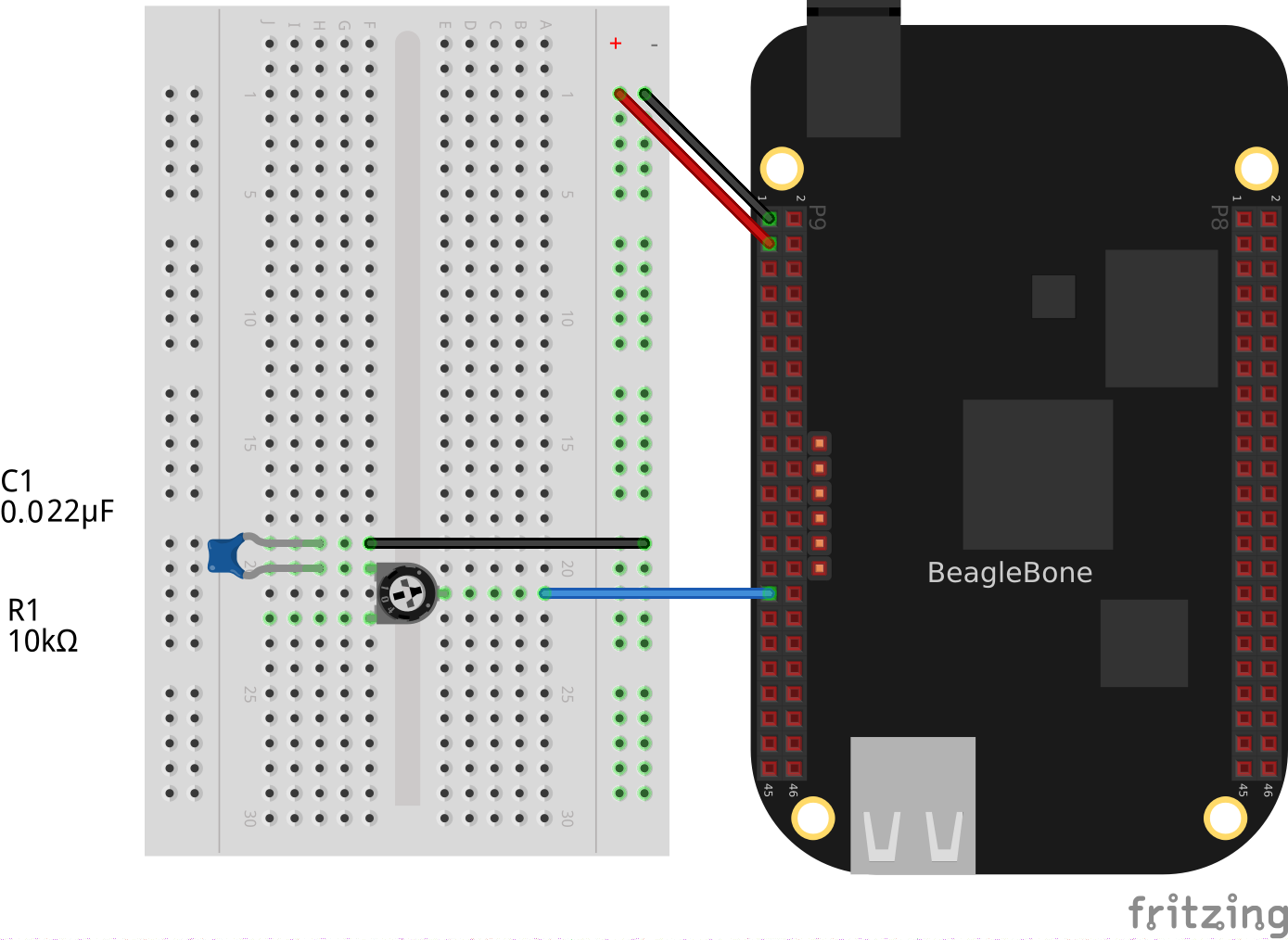
Fig. 515 Low-Pass Filter Wiring Diagram¶
Note
I used a 10K variable resistor and a 0.022uF capacitor. Probe the circuit between the resistor and the capacitor and adjust the resistor until you get a good looking waveform.
Reconstructed Sawtooth Waveform shows the results for filtered the SAWTOOTH.

Fig. 516 Reconstructed Sawtooth Waveform¶
Now that looks more like a sawtooth wave. The top plot is the time-domain plot of the output of the low-pass filter. The bottom plot is the FFT of the top plot, therefore it’s the frequency domain. We are getting a sawtooth with a frequency of about 6.1KHz. You can see the fundamental frequency on the bottom plot along with several harmonics.
The top looks like a sawtooth wave, but there is a high freqnecy superimposed on it. We are only using a simple first-order filter. You could lower the cutoff freqnecy by adjusting the resistor. You’ll see something like Reconstructed Sawtooth Waveform with Lower Cutoff Frequency.
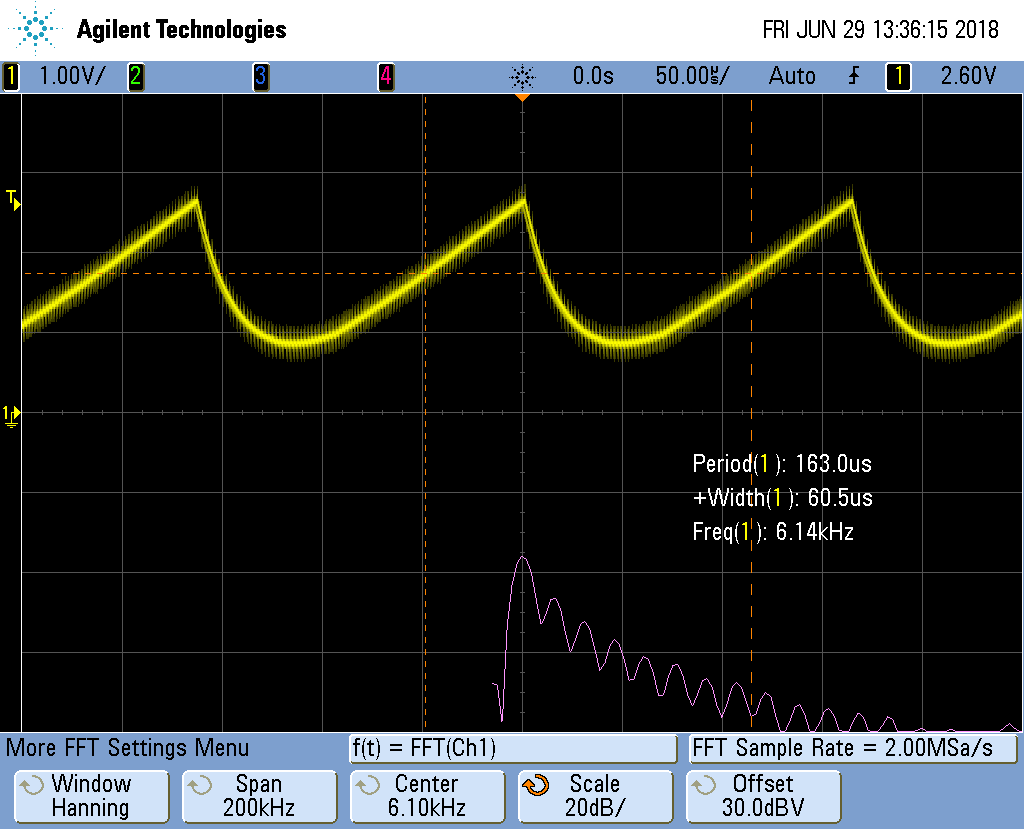
Fig. 517 Reconstructed Sawtooth Waveform with Lower Cutoff Frequency¶
The high frequencies have been reduced, but the corner of the waveform has been rounded. You can also adjust the cutoff to a higher frequency and you’ll get a sharper corner, but you’ll also get more high frequencies. See Reconstructed Sawtooth Waveform with Higher Cutoff Frequency
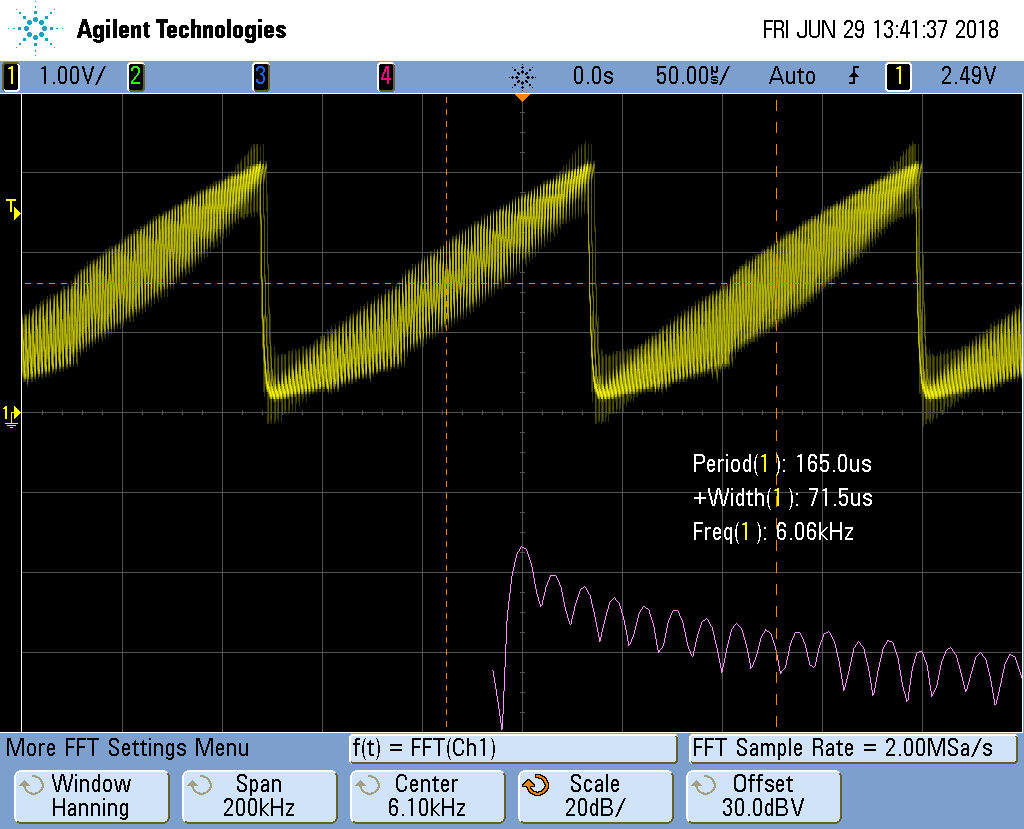
Fig. 518 Reconstructed Sawtooth Waveform with Higher Cutoff Frequency¶
Adjust to taste, though the real solution is to build a higher order filter. Search for _second order filter and you’ll find some nice circuits.
You can adjust the frequency of the signal by adjusting MAXT. A smaller
MAXT will give a higher frequency. I’ve gotten good results with MAXT
as small as 20.
You can also get a triangle waveform by setting the #define.
Reconstructed Triangle Waveform shows the output signal.

Fig. 519 Reconstructed Triangle Waveform¶
And also the sine wave as shown in Reconstructed Sinusoid Waveform.

Fig. 520 Reconstructed Sinusoid Waveform¶
Notice on the bottom plot the harmonics are much more suppressed.
Generating the sine waveform uses floats. This requires much more code. You can look in /tmp/vsx-examples/sine.pru0.map to see how much memory is being used. /tmp/vsx-examples/sine.pru0.map for Sine Wave shows the first few lines for the sine wave.
1******************************************************************************
2PRU Linker Unix v2.1.5
3******************************************************************************
4>> Linked Fri Jun 29 13:58:08 2018
5
6OUTPUT FILE NAME: </tmp/pru0-gen/sine1.out>
7ENTRY POINT SYMBOL: "_c_int00_noinit_noargs_noexit" address: 00000000
8
9
10MEMORY CONFIGURATION
11
12 name origin length used unused attr fill
13---------------------- -------- --------- -------- -------- ---- --------
14PAGE 0:
15 PRU_IMEM 00000000 00002000 000018c0 00000740 RWIX
16
17PAGE 1:
18 PRU_DMEM_0_1 00000000 00002000 00000154 00001eac RWIX
19 PRU_DMEM_1_0 00002000 00002000 00000000 00002000 RWIX
20
21PAGE 2:
22 PRU_SHAREDMEM 00010000 00003000 00000000 00003000 RWIX
23 PRU_INTC 00020000 00001504 00000000 00001504 RWIX
24 PRU_CFG 00026000 00000044 00000044 00000000 RWIX
25 PRU_UART 00028000 00000038 00000000 00000038 RWIX
26 PRU_IEP 0002e000 0000031c 00000000 0000031c RWIX
27 PRU_ECAP 00030000 00000060 00000000 00000060 RWIX
28 RSVD27 00032000 00000100 00000000 00000100 RWIX
29 RSVD21 00032400 00000100 00000000 00000100 RWIX
30 L3OCMC 40000000 00010000 00000000 00010000 RWIX
31 MCASP0_DMA 46000000 00000100 00000000 00000100 RWIX
32 UART1 48022000 00000088 00000000 00000088 RWIX
33 UART2 48024000 00000088 00000000 00000088 RWIX
34 I2C1 4802a000 000000d8 00000000 000000d8 RWIX
35 MCSPI0 48030000 000001a4 00000000 000001a4 RWIX
36 DMTIMER2 48040000 0000005c 00000000 0000005c RWIX
37 MMCHS0 48060000 00000300 00000000 00000300 RWIX
38 MBX0 480c8000 00000140 00000000 00000140 RWIX
39 SPINLOCK 480ca000 00000880 00000000 00000880 RWIX
40 I2C2 4819c000 000000d8 00000000 000000d8 RWIX
41 MCSPI1 481a0000 000001a4 00000000 000001a4 RWIX
42 DCAN0 481cc000 000001e8 00000000 000001e8 RWIX
43 DCAN1 481d0000 000001e8 00000000 000001e8 RWIX
44 PWMSS0 48300000 000002c4 00000000 000002c4 RWIX
45 PWMSS1 48302000 000002c4 00000000 000002c4 RWIX
46 PWMSS2 48304000 000002c4 00000000 000002c4 RWIX
47 RSVD13 48310000 00000100 00000000 00000100 RWIX
48 RSVD10 48318000 00000100 00000000 00000100 RWIX
49 TPCC 49000000 00001098 00000000 00001098 RWIX
50 GEMAC 4a100000 0000128c 00000000 0000128c RWIX
51 DDR 80000000 00000100 00000000 00000100 RWIX
52
53
54SECTION ALLOCATION MAP
55
56 output attributes/
57section page origin length input sections
58-------- ---- ---------- ---------- ----------------
59.text:_c_int00*
60* 0 00000000 00000014
61 00000000 00000014 rtspruv3_le.lib : boot_special.obj (.text:_c_int00_noinit_noargs_noexit)
62
63.text 0 00000014 000018ac
64 00000014 00000374 rtspruv3_le.lib : sin.obj (.text:sin)
65 00000388 00000314 : frcmpyd.obj (.text:__TI_frcmpyd)
66 0000069c 00000258 : frcaddd.obj (.text:__TI_frcaddd)
67 000008f4 00000254 : mpyd.obj (.text:__pruabi_mpyd)
68 00000b48 00000248 : addd.obj (.text:__pruabi_addd)
69 00000d90 000001c8 : mpyf.obj (.text:__pruabi_mpyf)
70 00000f58 00000100 : modf.obj (.text:modf)
71 00001058 000000b4 : gtd.obj (.text:__pruabi_gtd)
72 0000110c 000000b0 : ged.obj (.text:__pruabi_ged)
73 000011bc 000000b0 : ltd.obj (.text:__pruabi_ltd)
74 0000126c 000000b0 sine1.obj (.text:main)
75 0000131c 000000a8 rtspruv3_le.lib : frcmpyf.obj (.text:__TI_frcmpyf)
76 000013c4 000000a0 : fixdu.obj (.text:__pruabi_fixdu)
77 00001464 0000009c : round.obj (.text:__pruabi_nround)
78 00001500 00000090 : eqld.obj (.text:__pruabi_eqd)
79 00001590 0000008c : renormd.obj (.text:__TI_renormd)
80 0000161c 0000008c : fixdi.obj (.text:__pruabi_fixdi)
81 000016a8 00000084 : fltid.obj (.text:__pruabi_fltid)
82 0000172c 00000078 : cvtfd.obj (.text:__pruabi_cvtfd)
83 000017a4 00000050 : fltuf.obj (.text:__pruabi_fltuf)
84 000017f4 0000002c : asri.obj (.text:__pruabi_asri)
85 00001820 0000002c : subd.obj (.text:__pruabi_subd)
86 0000184c 00000024 : mpyi.obj (.text:__pruabi_mpyi)
87 00001870 00000020 : negd.obj (.text:__pruabi_negd)
88 00001890 00000020 : trunc.obj (.text:__pruabi_trunc)
89 000018b0 00000008 : exit.obj (.text:abort)
90 000018b8 00000008 : exit.obj (.text:loader_exit)
91
92.stack 1 00000000 00000100 UNINITIALIZED
93 00000000 00000004 rtspruv3_le.lib : boot.obj (.stack)
94 00000004 000000fc --HOLE--
95
96.cinit 1 00000000 00000000 UNINITIALIZED
97
98.fardata 1 00000100 00000040
99 00000100 00000040 rtspruv3_le.lib : sin.obj (.fardata:R$1)
100
101.resource_table
102* 1 00000140 00000014
103 00000140 00000014 sine1.obj (.resource_table:retain)
104
105.creg.PRU_CFG.noload.near
106* 2 00026000 00000044 NOLOAD SECTION
107 00026000 00000044 sine1.obj (.creg.PRU_CFG.noload.near)
108
109.creg.PRU_CFG.near
110* 2 00026044 00000000 UNINITIALIZED
111
112.creg.PRU_CFG.noload.far
113* 2 00026044 00000000 NOLOAD SECTION
114
115.creg.PRU_CFG.far
116* 2 00026044 00000000 UNINITIALIZED
117
118
119SEGMENT ATTRIBUTES
120
121 id tag seg value
122 -- --- --- -----
123 0 PHA_PAGE 1 1
124 1 PHA_PAGE 2 1
125
126
127GLOBAL SYMBOLS: SORTED ALPHABETICALLY BY Name
128
129page address name
130---- ------- ----
1310 000018b8 C$$EXIT
1322 00026000 CT_CFG
133abs 481cc000 __PRU_CREG_BASE_DCAN0
134abs 481d0000 __PRU_CREG_BASE_DCAN1
135abs 80000000 __PRU_CREG_BASE_DDR
136abs 48040000 __PRU_CREG_BASE_DMTIMER2
137abs 4a100000 __PRU_CREG_BASE_GEMAC
138abs 4802a000 __PRU_CREG_BASE_I2C1
139abs 4819c000 __PRU_CREG_BASE_I2C2
140abs 40000000 __PRU_CREG_BASE_L3OCMC
141abs 480c8000 __PRU_CREG_BASE_MBX0
142abs 46000000 __PRU_CREG_BASE_MCASP0_DMA
143abs 48030000 __PRU_CREG_BASE_MCSPI0
144abs 481a0000 __PRU_CREG_BASE_MCSPI1
145abs 48060000 __PRU_CREG_BASE_MMCHS0
146abs 00026000 __PRU_CREG_BASE_PRU_CFG
147abs 00000000 __PRU_CREG_BASE_PRU_DMEM_0_1
148abs 00002000 __PRU_CREG_BASE_PRU_DMEM_1_0
149abs 00030000 __PRU_CREG_BASE_PRU_ECAP
150abs 0002e000 __PRU_CREG_BASE_PRU_IEP
151abs 00020000 __PRU_CREG_BASE_PRU_INTC
152abs 00010000 __PRU_CREG_BASE_PRU_SHAREDMEM
153abs 00028000 __PRU_CREG_BASE_PRU_UART
154abs 48300000 __PRU_CREG_BASE_PWMSS0
155abs 48302000 __PRU_CREG_BASE_PWMSS1
156abs 48304000 __PRU_CREG_BASE_PWMSS2
157abs 48318000 __PRU_CREG_BASE_RSVD10
158abs 48310000 __PRU_CREG_BASE_RSVD13
159abs 00032400 __PRU_CREG_BASE_RSVD21
160abs 00032000 __PRU_CREG_BASE_RSVD27
161abs 480ca000 __PRU_CREG_BASE_SPINLOCK
162abs 49000000 __PRU_CREG_BASE_TPCC
163abs 48022000 __PRU_CREG_BASE_UART1
164abs 48024000 __PRU_CREG_BASE_UART2
165abs 0000000e __PRU_CREG_DCAN0
166abs 0000000f __PRU_CREG_DCAN1
167abs 0000001f __PRU_CREG_DDR
168abs 00000001 __PRU_CREG_DMTIMER2
169abs 00000009 __PRU_CREG_GEMAC
170abs 00000002 __PRU_CREG_I2C1
171abs 00000011 __PRU_CREG_I2C2
172abs 0000001e __PRU_CREG_L3OCMC
173abs 00000016 __PRU_CREG_MBX0
174abs 00000008 __PRU_CREG_MCASP0_DMA
175abs 00000006 __PRU_CREG_MCSPI0
176abs 00000010 __PRU_CREG_MCSPI1
177abs 00000005 __PRU_CREG_MMCHS0
178abs 00000004 __PRU_CREG_PRU_CFG
179abs 00000018 __PRU_CREG_PRU_DMEM_0_1
180abs 00000019 __PRU_CREG_PRU_DMEM_1_0
181abs 00000003 __PRU_CREG_PRU_ECAP
182abs 0000001a __PRU_CREG_PRU_IEP
183abs 00000000 __PRU_CREG_PRU_INTC
184abs 0000001c __PRU_CREG_PRU_SHAREDMEM
185abs 00000007 __PRU_CREG_PRU_UART
186abs 00000012 __PRU_CREG_PWMSS0
187abs 00000013 __PRU_CREG_PWMSS1
188abs 00000014 __PRU_CREG_PWMSS2
189abs 0000000a __PRU_CREG_RSVD10
190abs 0000000d __PRU_CREG_RSVD13
191abs 00000015 __PRU_CREG_RSVD21
192abs 0000001b __PRU_CREG_RSVD27
193abs 00000017 __PRU_CREG_SPINLOCK
194abs 0000001d __PRU_CREG_TPCC
195abs 0000000b __PRU_CREG_UART1
196abs 0000000c __PRU_CREG_UART2
1971 00000100 __TI_STACK_END
198abs 00000100 __TI_STACK_SIZE
1990 0000069c __TI_frcaddd
2000 00000388 __TI_frcmpyd
2010 0000131c __TI_frcmpyf
2020 00001590 __TI_renormd
203abs ffffffff __binit__
204abs ffffffff __c_args__
2050 00000b48 __pruabi_addd
2060 000017f4 __pruabi_asri
2070 0000172c __pruabi_cvtfd
2080 00001500 __pruabi_eqd
2090 0000161c __pruabi_fixdi
2100 000013c4 __pruabi_fixdu
2110 000016a8 __pruabi_fltid
2120 000017a4 __pruabi_fltuf
2130 0000110c __pruabi_ged
2140 00001058 __pruabi_gtd
2150 000011bc __pruabi_ltd
2160 000008f4 __pruabi_mpyd
2170 00000d90 __pruabi_mpyf
2180 0000184c __pruabi_mpyi
2190 00001870 __pruabi_negd
2200 00001464 __pruabi_nround
2210 00001820 __pruabi_subd
2220 00001890 __pruabi_trunc
2230 00000000 _c_int00_noinit_noargs_noexit
2241 00000000 _stack
2250 000018b0 abort
226abs ffffffff binit
2270 0000126c main
2280 00000f58 modf
2291 00000140 pru_remoteproc_ResourceTable
2300 00000014 sin
231
232
233GLOBAL SYMBOLS: SORTED BY Symbol Address
234
235page address name
236---- ------- ----
2370 00000000 _c_int00_noinit_noargs_noexit
2380 00000014 sin
2390 00000388 __TI_frcmpyd
2400 0000069c __TI_frcaddd
2410 000008f4 __pruabi_mpyd
2420 00000b48 __pruabi_addd
2430 00000d90 __pruabi_mpyf
2440 00000f58 modf
2450 00001058 __pruabi_gtd
2460 0000110c __pruabi_ged
2470 000011bc __pruabi_ltd
2480 0000126c main
2490 0000131c __TI_frcmpyf
2500 000013c4 __pruabi_fixdu
2510 00001464 __pruabi_nround
2520 00001500 __pruabi_eqd
2530 00001590 __TI_renormd
2540 0000161c __pruabi_fixdi
2550 000016a8 __pruabi_fltid
2560 0000172c __pruabi_cvtfd
2570 000017a4 __pruabi_fltuf
2580 000017f4 __pruabi_asri
2590 00001820 __pruabi_subd
2600 0000184c __pruabi_mpyi
2610 00001870 __pruabi_negd
2620 00001890 __pruabi_trunc
2630 000018b0 abort
2640 000018b8 C$$EXIT
2651 00000000 _stack
2661 00000100 __TI_STACK_END
2671 00000140 pru_remoteproc_ResourceTable
2682 00026000 CT_CFG
269abs 00000000 __PRU_CREG_BASE_PRU_DMEM_0_1
270abs 00000000 __PRU_CREG_PRU_INTC
271abs 00000001 __PRU_CREG_DMTIMER2
272abs 00000002 __PRU_CREG_I2C1
273abs 00000003 __PRU_CREG_PRU_ECAP
274abs 00000004 __PRU_CREG_PRU_CFG
275abs 00000005 __PRU_CREG_MMCHS0
276abs 00000006 __PRU_CREG_MCSPI0
277abs 00000007 __PRU_CREG_PRU_UART
278abs 00000008 __PRU_CREG_MCASP0_DMA
279abs 00000009 __PRU_CREG_GEMAC
280abs 0000000a __PRU_CREG_RSVD10
281abs 0000000b __PRU_CREG_UART1
282abs 0000000c __PRU_CREG_UART2
283abs 0000000d __PRU_CREG_RSVD13
284abs 0000000e __PRU_CREG_DCAN0
285abs 0000000f __PRU_CREG_DCAN1
286abs 00000010 __PRU_CREG_MCSPI1
287abs 00000011 __PRU_CREG_I2C2
288abs 00000012 __PRU_CREG_PWMSS0
289abs 00000013 __PRU_CREG_PWMSS1
290abs 00000014 __PRU_CREG_PWMSS2
291abs 00000015 __PRU_CREG_RSVD21
292abs 00000016 __PRU_CREG_MBX0
293abs 00000017 __PRU_CREG_SPINLOCK
294abs 00000018 __PRU_CREG_PRU_DMEM_0_1
295abs 00000019 __PRU_CREG_PRU_DMEM_1_0
296abs 0000001a __PRU_CREG_PRU_IEP
297abs 0000001b __PRU_CREG_RSVD27
298abs 0000001c __PRU_CREG_PRU_SHAREDMEM
299abs 0000001d __PRU_CREG_TPCC
300abs 0000001e __PRU_CREG_L3OCMC
301abs 0000001f __PRU_CREG_DDR
302abs 00000100 __TI_STACK_SIZE
303abs 00002000 __PRU_CREG_BASE_PRU_DMEM_1_0
304abs 00010000 __PRU_CREG_BASE_PRU_SHAREDMEM
305abs 00020000 __PRU_CREG_BASE_PRU_INTC
306abs 00026000 __PRU_CREG_BASE_PRU_CFG
307abs 00028000 __PRU_CREG_BASE_PRU_UART
308abs 0002e000 __PRU_CREG_BASE_PRU_IEP
309abs 00030000 __PRU_CREG_BASE_PRU_ECAP
310abs 00032000 __PRU_CREG_BASE_RSVD27
311abs 00032400 __PRU_CREG_BASE_RSVD21
312abs 40000000 __PRU_CREG_BASE_L3OCMC
313abs 46000000 __PRU_CREG_BASE_MCASP0_DMA
314abs 48022000 __PRU_CREG_BASE_UART1
315abs 48024000 __PRU_CREG_BASE_UART2
316abs 4802a000 __PRU_CREG_BASE_I2C1
317abs 48030000 __PRU_CREG_BASE_MCSPI0
318abs 48040000 __PRU_CREG_BASE_DMTIMER2
319abs 48060000 __PRU_CREG_BASE_MMCHS0
320abs 480c8000 __PRU_CREG_BASE_MBX0
321abs 480ca000 __PRU_CREG_BASE_SPINLOCK
322abs 4819c000 __PRU_CREG_BASE_I2C2
323abs 481a0000 __PRU_CREG_BASE_MCSPI1
324abs 481cc000 __PRU_CREG_BASE_DCAN0
325abs 481d0000 __PRU_CREG_BASE_DCAN1
326abs 48300000 __PRU_CREG_BASE_PWMSS0
327abs 48302000 __PRU_CREG_BASE_PWMSS1
328abs 48304000 __PRU_CREG_BASE_PWMSS2
329abs 48310000 __PRU_CREG_BASE_RSVD13
330abs 48318000 __PRU_CREG_BASE_RSVD10
331abs 49000000 __PRU_CREG_BASE_TPCC
332abs 4a100000 __PRU_CREG_BASE_GEMAC
333abs 80000000 __PRU_CREG_BASE_DDR
334abs ffffffff __binit__
335abs ffffffff __c_args__
336abs ffffffff binit
337
338[100 symbols]
Notice line 15 shows 0x18c0 bytes are being used for instructions. That’s 6336 in decimal.
Now compile for the sawtooth and you see only 444 byes are used. Floating-point requires over 5K more bytes. Use with care. If you are short on instruction space, you can move the table generation to the ARM and just copy the table to the PRU.
WS2812 (NeoPixel) driver¶
Problem¶
You have an Adafruit NeoPixel LED string or Adafruit NeoPixel LED matrix and want to light it up.
Solution¶
NeoPixel is Adafruit’s name for the WS2812 Intelligent control LED. Each NeoPixel contains a Red, Green and Blue LED with a PWM controller that can dim each one individually making a rainbow of colors possible. The NeoPixel is driven by a single serial line. The timing on the line is very sensesitive, which make the PRU a perfect candidate for driving it.
Wire the input to P9_29 and power to 3.3V and ground to ground as shown in
NeoPixel Wiring.
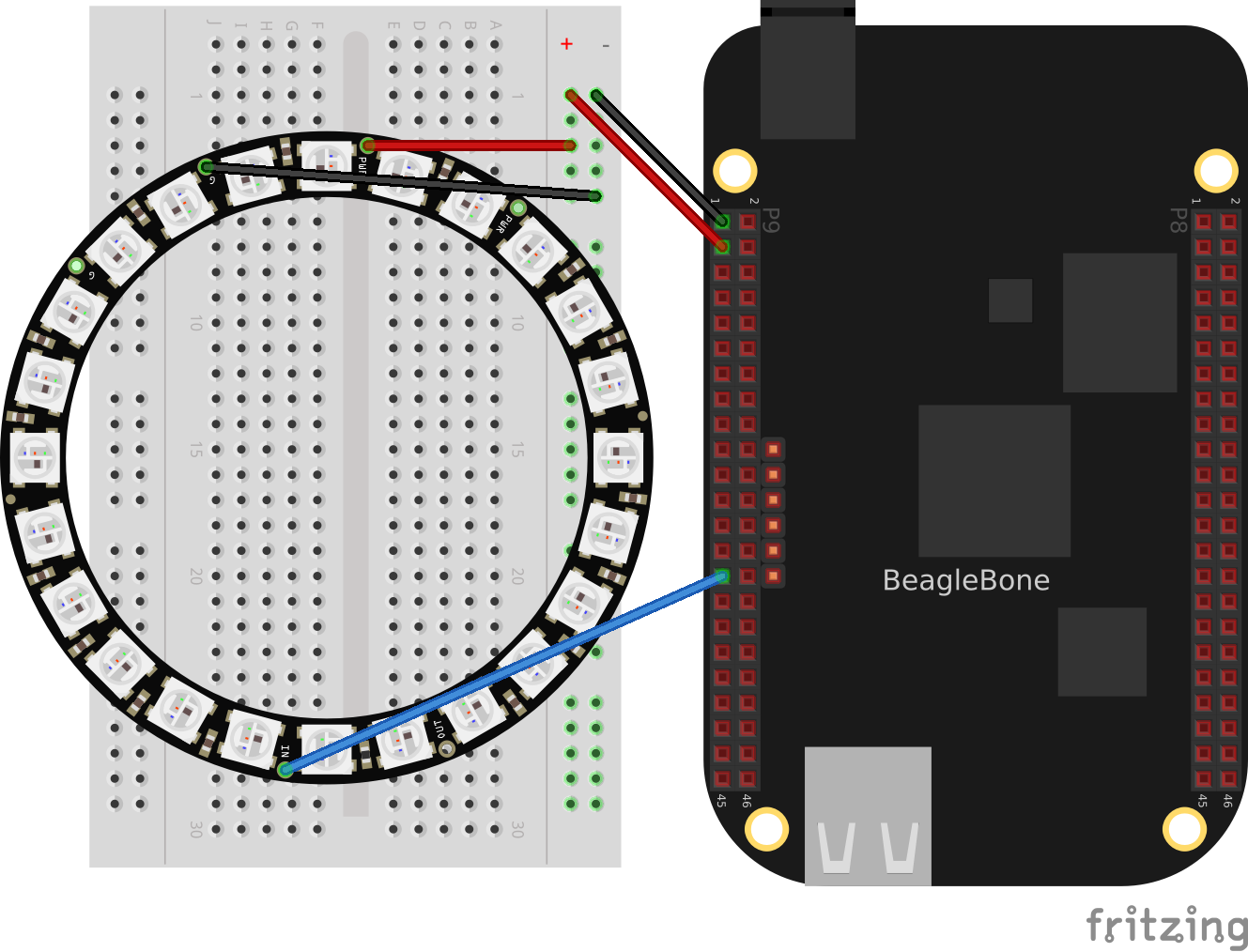
Fig. 521 NeoPixel Wiring¶
Test your wiring with the simple code in neo1.pru0.c - Code to turn all NeoPixels’s white which to turns all pixels white.
1// Control a ws2812 (NeoPixel) display, All on or all off
2#include <stdint.h>
3#include <pru_cfg.h>
4#include "resource_table_empty.h"
5#include "prugpio.h"
6
7#define STR_LEN 24
8#define oneCyclesOn 700/5 // Stay on 700ns
9#define oneCyclesOff 800/5
10#define zeroCyclesOn 350/5
11#define zeroCyclesOff 600/5
12#define resetCycles 60000/5 // Must be at least 50u, use 60u
13#define gpio P9_29 // output pin
14
15#define ONE
16
17volatile register uint32_t __R30;
18volatile register uint32_t __R31;
19
20void main(void)
21{
22 /* Clear SYSCFG[STANDBY_INIT] to enable OCP master port */
23 CT_CFG.SYSCFG_bit.STANDBY_INIT = 0;
24
25 uint32_t i;
26 for(i=0; i<STR_LEN*3*8; i++) {
27#ifdef ONE
28 __R30 |= gpio; // Set the GPIO pin to 1
29 __delay_cycles(oneCyclesOn-1);
30 __R30 &= ~gpio; // Clear the GPIO pin
31 __delay_cycles(oneCyclesOff-2);
32#else
33 __R30 |= gpio; // Set the GPIO pin to 1
34 __delay_cycles(zeroCyclesOn-1);
35 __R30 &= ~gpio; // Clear the GPIO pin
36 __delay_cycles(zeroCyclesOff-2);
37#endif
38 }
39 // Send Reset
40 __R30 &= ~gpio; // Clear the GPIO pin
41 __delay_cycles(resetCycles);
42
43 __halt();
44}
Discussion¶
NeoPixel bit sequence (taken from WS2812 Data Sheet) shows the following waveforms are used to send a bit of data.
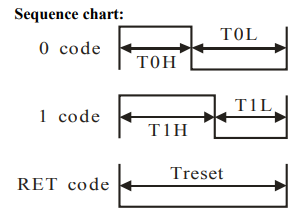
Fig. 522 NeoPixel bit sequence¶
Label |
Time in ns |
|---|---|
T0H |
350 |
T0L |
800 |
T1H |
700 |
T1L |
600 |
Treset |
>50,000 |
The code in neo1.pru0.c - Code to turn all NeoPixels’s white define these times in lines 7-10. The /5 is because each instruction take 5ns. Lines 27-30 then set the output to 1 for the desired time and then to 0 and keeps repeating it for the entire string length. NeoPixel zero timing shows the waveform for sending a 0 value. Note the times are spot on.
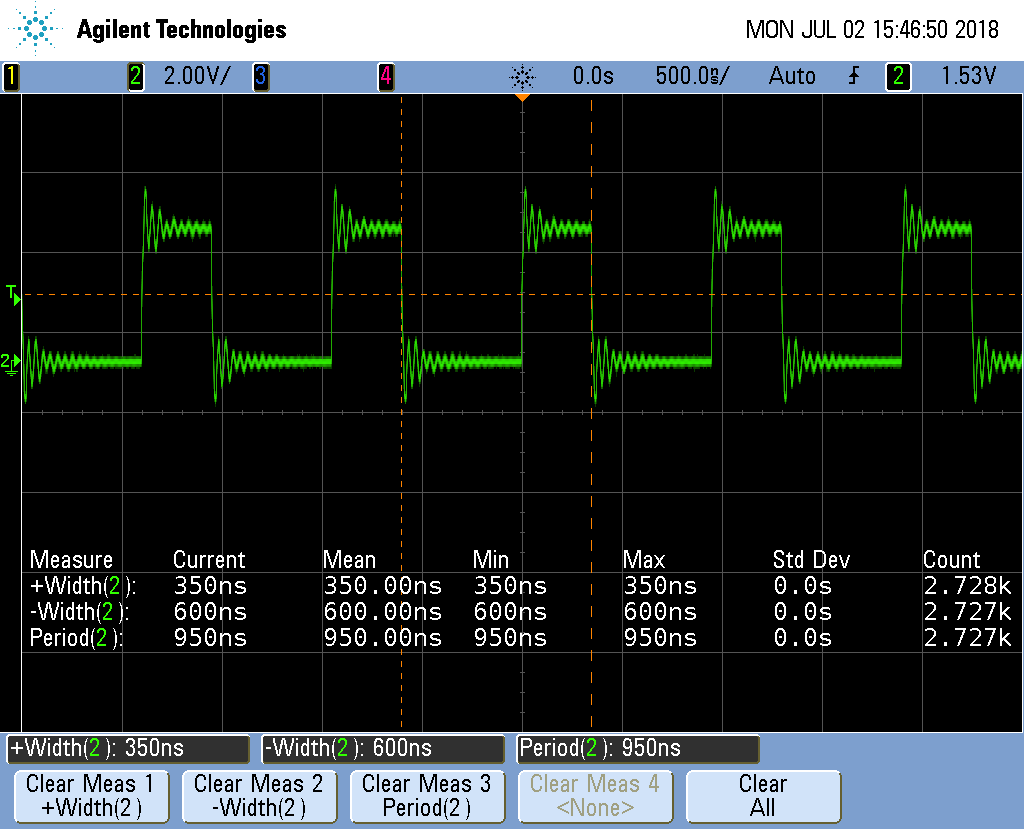
Fig. 523 NeoPixel zero timing¶
Each NeoPixel listens for a RGB value. Once a value has arrived all other values that follow are passed on to the next NeoPixel which does the same thing. That way you can individually control all of the NeoPixels.
Lines 38-40 send out a reset pulse. If a NeoPixel sees a reset pulse it will grab the next value for itself and start over again.
Setting NeoPixels to Different Colors¶
Problem¶
I want to set the LEDs to different colors.
Solution¶
Wire your NeoPixels as shown in NeoPixel Wiring then run the code in neo2.pru0.c - Code to turn on green, red, blue.
1// Control a ws2812 (neo pixel) display, green, red, blue, green, ...
2#include <stdint.h>
3#include <pru_cfg.h>
4#include "resource_table_empty.h"
5#include "prugpio.h"
6
7#define STR_LEN 3
8#define oneCyclesOn 700/5 // Stay on 700ns
9#define oneCyclesOff 800/5
10#define zeroCyclesOn 350/5
11#define zeroCyclesOff 600/5
12#define resetCycles 60000/5 // Must be at least 50u, use 60u
13#define gpio P9_29 // output pin
14
15volatile register uint32_t __R30;
16volatile register uint32_t __R31;
17
18void main(void)
19{
20 /* Clear SYSCFG[STANDBY_INIT] to enable OCP master port */
21 CT_CFG.SYSCFG_bit.STANDBY_INIT = 0;
22
23 uint32_t color[STR_LEN] = {0x0f0000, 0x000f00, 0x0000f}; // green, red, blue
24 int i, j;
25
26 for(j=0; j<STR_LEN; j++) {
27 for(i=23; i>=0; i--) {
28 if(color[j] & (0x1<<i)) {
29 __R30 |= gpio; // Set the GPIO pin to 1
30 __delay_cycles(oneCyclesOn-1);
31 __R30 &= ~gpio; // Clear the GPIO pin
32 __delay_cycles(oneCyclesOff-2);
33 } else {
34 __R30 |= gpio; // Set the GPIO pin to 1
35 __delay_cycles(zeroCyclesOn-1);
36 __R30 &= ~gpio; // Clear the GPIO pin
37 __delay_cycles(zeroCyclesOff-2);
38 }
39 }
40 }
41 // Send Reset
42 __R30 &= ~gpio; // Clear the GPIO pin
43 __delay_cycles(resetCycles);
44
45 __halt();
46}
This will make the first LED green, the second red and the third blue.
Discussion¶
NeoPixel data sequence shows the sequence of bits used to control the green, red and blue values.

Fig. 524 NeoPixel data sequence¶
Note
The usual order for colors is RGB (red, green, blue), but the NeoPixels use GRB (green, red, blue).
Line-by-line for neo2.pru0.c is the line-by-line for neo2.pru0.c.
Line 23 |
Explanation Define the string of colors to be output. Here the ordering of the bits is the same as NeoPixel data sequence, GRB. |
26 |
Loop for each color to output. |
27 |
Loop for each bit in an GRB color. |
28 |
Get the j^th^ color and mask off all but the i^th^ bit. (0x1:ref:`i) takes the value 0x1 and shifts it left i bits. When anded (&) with color[j] it will zero out all but the i^th^ bit. If the result of the operation is 1, the if is done, otherwise the else is done. |
29-32 |
Send a 1. |
34-37 |
Send a 0. |
42-43 |
Send a reset pulse once all the colors have been sent. |
Note
This will only change the first STR_LEN LEDs. The LEDs that follow will not be changed.
Controlling Arbitrary LEDs¶
Problem¶
I want to change the 10^th^ LED and not have to change the others.
Solution¶
You need to keep an array of colors for the whole string in the PRU. Change the color of any pixels you want in the array and then send out the whole string to the LEDs. neo3.pru0.c - Code to animate a red pixel running around a ring of blue shows an example animates a red pixel running around a ring of blue background. Neo3 Video shows the code in action.
1// Control a ws2812 (neo pixel) display, green, red, blue, green, ...
2#include <stdint.h>
3#include <pru_cfg.h>
4#include "resource_table_empty.h"
5#include "prugpio.h"
6
7#define STR_LEN 24
8#define oneCyclesOn 700/5 // Stay on 700ns
9#define oneCyclesOff 800/5
10#define zeroCyclesOn 350/5
11#define zeroCyclesOff 600/5
12#define resetCycles 60000/5 // Must be at least 50u, use 60u
13#define gpio P9_29 // output pin
14
15#define SPEED 20000000/5 // Time to wait between updates
16
17volatile register uint32_t __R30;
18volatile register uint32_t __R31;
19
20void main(void)
21{
22 uint32_t background = 0x00000f;
23 uint32_t foreground = 0x000f00;
24
25 /* Clear SYSCFG[STANDBY_INIT] to enable OCP master port */
26 CT_CFG.SYSCFG_bit.STANDBY_INIT = 0;
27
28 uint32_t color[STR_LEN]; // green, red, blue
29 int i, j;
30 int k, oldk = 0;;
31 // Set everything to background
32 for(i=0; i<STR_LEN; i++) {
33 color[i] = background;
34 }
35
36 while(1) {
37 // Move forward one position
38 for(k=0; k<STR_LEN; k++) {
39 color[oldk] = background;
40 color[k] = foreground;
41 oldk=k;
42
43 // Output the string
44 for(j=0; j<STR_LEN; j++) {
45 for(i=23; i>=0; i--) {
46 if(color[j] & (0x1<<i)) {
47 __R30 |= gpio; // Set the GPIO pin to 1
48 __delay_cycles(oneCyclesOn-1);
49 __R30 &= ~gpio; // Clear the GPIO pin
50 __delay_cycles(oneCyclesOff-2);
51 } else {
52 __R30 |= gpio; // Set the GPIO pin to 1
53 __delay_cycles(zeroCyclesOn-1);
54 __R30 &= ~gpio; // Clear the GPIO pin
55 __delay_cycles(zeroCyclesOff-2);
56 }
57 }
58 }
59 // Send Reset
60 __R30 &= ~gpio; // Clear the GPIO pin
61 __delay_cycles(resetCycles);
62
63 // Wait
64 __delay_cycles(SPEED);
65 }
66 }
67}
Neo3 Video¶
Discussion¶
Line |
Explanation |
|---|---|
32,33 |
Initiallize the array of colors. |
38-41 |
Update the array. |
44-58 |
Send the array to the LEDs. |
60-61 |
Send a reset. |
64 |
Wait a bit. |
Controlling NeoPixels Through a Kernel Driver¶
Problem¶
You want to control your NeoPixels through a kernel driver so you can control it
through a /dev interface.
Solution¶
The rpmsg_pru driver provides a way to pass data between the ARM processor and the PRUs. It’s already included on current images. neo4.pru0.c - Code to talk to the PRU via rpmsg_pru shows an example.
1// Use rpmsg to control the NeoPixels via /dev/rpmsg_pru30
2#include <stdint.h>
3#include <stdio.h>
4#include <stdlib.h> // atoi
5#include <string.h>
6#include <pru_cfg.h>
7#include <pru_intc.h>
8#include <rsc_types.h>
9#include <pru_rpmsg.h>
10#include "resource_table_0.h"
11#include "prugpio.h"
12
13volatile register uint32_t __R30;
14volatile register uint32_t __R31;
15
16/* Host-0 Interrupt sets bit 30 in register R31 */
17#define HOST_INT ((uint32_t) 1 << 30)
18
19/* The PRU-ICSS system events used for RPMsg are defined in the Linux device tree
20 * PRU0 uses system event 16 (To ARM) and 17 (From ARM)
21 * PRU1 uses system event 18 (To ARM) and 19 (From ARM)
22 */
23#define TO_ARM_HOST 16
24#define FROM_ARM_HOST 17
25
26/*
27* Using the name 'rpmsg-pru' will probe the rpmsg_pru driver found
28* at linux-x.y.z/drivers/rpmsg/rpmsg_pru.c
29*/
30#define CHAN_NAME "rpmsg-pru"
31#define CHAN_DESC "Channel 30"
32#define CHAN_PORT 30
33
34/*
35 * Used to make sure the Linux drivers are ready for RPMsg communication
36 * Found at linux-x.y.z/include/uapi/linux/virtio_config.h
37 */
38#define VIRTIO_CONFIG_S_DRIVER_OK 4
39
40char payload[RPMSG_BUF_SIZE];
41
42#define STR_LEN 24
43#define oneCyclesOn 700/5 // Stay on for 700ns
44#define oneCyclesOff 600/5
45#define zeroCyclesOn 350/5
46#define zeroCyclesOff 800/5
47#define resetCycles 51000/5 // Must be at least 50u, use 51u
48#define out P9_29 // Bit number to output on
49
50#define SPEED 20000000/5 // Time to wait between updates
51
52uint32_t color[STR_LEN]; // green, red, blue
53
54/*
55 * main.c
56 */
57void main(void)
58{
59 struct pru_rpmsg_transport transport;
60 uint16_t src, dst, len;
61 volatile uint8_t *status;
62
63 uint8_t r, g, b;
64 int i, j;
65 // Set everything to background
66 for(i=0; i<STR_LEN; i++) {
67 color[i] = 0x010000;
68 }
69
70 /* Allow OCP master port access by the PRU so the PRU can read external memories */
71 CT_CFG.SYSCFG_bit.STANDBY_INIT = 0;
72
73 /* Clear the status of the PRU-ICSS system event that the ARM will use to 'kick' us */
74#ifdef CHIP_IS_am57xx
75 CT_INTC.SICR_bit.STATUS_CLR_INDEX = FROM_ARM_HOST;
76#else
77 CT_INTC.SICR_bit.STS_CLR_IDX = FROM_ARM_HOST;
78#endif
79
80 /* Make sure the Linux drivers are ready for RPMsg communication */
81 status = &resourceTable.rpmsg_vdev.status;
82 while (!(*status & VIRTIO_CONFIG_S_DRIVER_OK));
83
84 /* Initialize the RPMsg transport structure */
85 pru_rpmsg_init(&transport, &resourceTable.rpmsg_vring0, &resourceTable.rpmsg_vring1, TO_ARM_HOST, FROM_ARM_HOST);
86
87 /* Create the RPMsg channel between the PRU and ARM user space using the transport structure. */
88 while (pru_rpmsg_channel(RPMSG_NS_CREATE, &transport, CHAN_NAME, CHAN_DESC, CHAN_PORT) != PRU_RPMSG_SUCCESS);
89 while (1) {
90 /* Check bit 30 of register R31 to see if the ARM has kicked us */
91 if (__R31 & HOST_INT) {
92 /* Clear the event status */
93#ifdef CHIP_IS_am57xx
94 CT_INTC.SICR_bit.STATUS_CLR_INDEX = FROM_ARM_HOST;
95#else
96 CT_INTC.SICR_bit.STS_CLR_IDX = FROM_ARM_HOST;
97#endif
98 /* Receive all available messages, multiple messages can be sent per kick */
99 while (pru_rpmsg_receive(&transport, &src, &dst, payload, &len) == PRU_RPMSG_SUCCESS) {
100 char *ret; // rest of payload after front character is removed
101 int index; // index of LED to control
102 // Input format is: index red green blue
103 index = atoi(payload);
104 // Update the array, but don't write it out.
105 if((index >=0) & (index < STR_LEN)) {
106 ret = strchr(payload, ' '); // Skip over index
107 r = strtol(&ret[1], NULL, 0);
108 ret = strchr(&ret[1], ' '); // Skip over r, etc.
109 g = strtol(&ret[1], NULL, 0);
110 ret = strchr(&ret[1], ' ');
111 b = strtol(&ret[1], NULL, 0);
112
113 color[index] = (g<<16)|(r<<8)|b; // String wants GRB
114 }
115 // When index is -1, send the array to the LED string
116 if(index == -1) {
117 // Output the string
118 for(j=0; j<STR_LEN; j++) {
119 // Cycle through each bit
120 for(i=23; i>=0; i--) {
121 if(color[j] & (0x1<<i)) {
122 __R30 |= out; // Set the GPIO pin to 1
123 __delay_cycles(oneCyclesOn-1);
124 __R30 &= ~out; // Clear the GPIO pin
125 __delay_cycles(oneCyclesOff-14);
126 } else {
127 __R30 |= out; // Set the GPIO pin to 1
128 __delay_cycles(zeroCyclesOn-1);
129 __R30 &= ~(out); // Clear the GPIO pin
130 __delay_cycles(zeroCyclesOff-14);
131 }
132 }
133 }
134 // Send Reset
135 __R30 &= ~out; // Clear the GPIO pin
136 __delay_cycles(resetCycles);
137
138 // Wait
139 __delay_cycles(SPEED);
140 }
141
142 }
143 }
144 }
145}
Run the code as usual.
bone$ make TARGET=neo4.pru0
/opt/source/pru-cookbook-code/common/Makefile:29: MODEL=TI_AM335x_BeagleBone_Black,TARGET=neo4.pru0
- Stopping PRU 0
- copying firmware file /tmp/vsx-examples/neo4.pru0.out to /lib/firmware/am335x-pru0-fw
write_init_pins.sh
- Starting PRU 0
MODEL = TI_AM335x_BeagleBone_Black
PROC = pru
PRUN = 0
PRU_DIR = /sys/class/remoteproc/remoteproc1
bone$ echo 0 0xff 0 127 > /dev/rpmsg_pru30
bone$ echo -1 > /dev/rpmsg_pru30
/dev/rpmsg_pru30 is a device driver that lets the ARM talk to the PRU.
The first echo says to set the 0^th^ LED to RGB value 0xff 0 127. (Note: you can
mix hex and decimal.) The second echo tells the driver to send the data to the
LEDs. Your 0^th^ LED should now be lit.
Discussion¶
There’s a lot here. I’ll just hit some of the highlights in Line-by-line for neo4.pru0.c.
Line |
Explanation |
|---|---|
30 |
The CHAN_NAME of rpmsg-pru matches that prmsg_pru driver that is is already installed. This connects this PRU to the driver. |
32 |
The CHAN_PORT tells it to use port 30. That’s why we use /dev/rpmsg_pru30 |
40 |
payload[] is the buffer that receives the data from the ARM. |
42-48 |
Same as the previous NeoPixel examples. |
52 |
color[] is the state to be sent to the LEDs. |
66-68 |
color[] is initialized. |
70-85 |
Here are a number of details needed to set up the channel between the PRU and the ARM. |
88 |
Here we wait until the ARM sends us some numbers. |
99 |
Receive all the data from the ARM, store it in payload[]. |
101-111 |
The data sent is: index red green blue. Pull off the index. If it’s in the right range, pull off the red, green and blue values. |
113 |
The NeoPixels want the data in GRB order. Shift and OR everything together. |
116-133 |
If the index = -1, send the contents of color to the LEDs. This code is same as before. |
You can now use programs running on the ARM to send colors to the PRU.
neo-rainbow.py - A python program using /dev/rpmsg_pru30 shows an example.
1#!/usr/bin/python3
2from time import sleep
3import math
4
5len = 24
6amp = 12
7f = 25
8shift = 3
9phase = 0
10
11# Open a file
12fo = open("/dev/rpmsg_pru30", "wb", 0)
13
14while True:
15 for i in range(0, len):
16 r = (amp * (math.sin(2*math.pi*f*(i-phase-0*shift)/len) + 1)) + 1;
17 g = (amp * (math.sin(2*math.pi*f*(i-phase-1*shift)/len) + 1)) + 1;
18 b = (amp * (math.sin(2*math.pi*f*(i-phase-2*shift)/len) + 1)) + 1;
19 fo.write(b"%d %d %d %d\n" % (i, r, g, b))
20 # print("0 0 127 %d" % (i))
21
22 fo.write(b"-1 0 0 0\n");
23 phase = phase + 1
24 sleep(0.05)
25
26# Close opened file
27fo.close()
Line 19 writes the data to the PRU. Be sure to have a newline, or space after the last number, or you numbers will get blurred together.
Switching from pru0 to pru1 with rpmsg_pru¶
There are three things you need to change when switching from pru0 to pru1 when using rpmsg_pru.
The include on line 10 is switched to
#include "resource_table_1.h"(0 is switched to a 1)Line 17 is switched to
#define HOST_INT ((uint32_t) 1 << 31)(30 is switched to 31.)Lines 23 and 24 are switched to:
#define TO_ARM_HOST 18
#define FROM_ARM_HOST 19
These changes switch to the proper channel numbers to use pru1 instead of pru0.
RGB LED Matrix - No Integrated Drivers¶
Problem¶
You have a RGB LED matrix (RGB LED Matrix – No Integrated Drivers (Falcon Christmas)) and want to know at a low level how the PRU works.
Solution¶
Here is the datasheet, but the best description I’ve found for the RGB Matrix is from Adafruit. I’ve reproduced it here, with adjustments for the 64x32 matrix we are using.
information
There’s zero documentation out there on how these matrices work, and no public datasheets or spec sheets so we are going to try to document how they work.
First thing to notice is that there are 2048 RGB LEDs in a 64x32 matrix. Like pretty much every matrix out there, you can’t drive all 2048 at once. One reason is that would require a lot of current, another reason is that it would be really expensive to have so many pins. Instead, the matrix is divided into 16 interleaved sections/strips. The first section is the 1^st^ ‘line’ and the 17^th^ ‘line’ (64 x 2 RGB LEDs = 128 RGB LEDs), the second is the 2^nd^ and 18^th^ line, etc until the last section which is the 16^th^ and 32^nd^ line. You might be asking, why are the lines paired this way? wouldn’t it be nicer to have the first section be the 1^st^ and 2^nd^ line, then 3^rd^ and 4^th^, until the 15^th^ and 16^th^? The reason they do it this way is so that the lines are interleaved and look better when refreshed, otherwise we’d see the stripes more clearly.
So, on the PCB is 24 LED driver chips. These are like 74HC595s but they have 16 outputs and they are constant current. 16 outputs * 24 chips = 384 LEDs that can be controlled at once, and 128 * 3 (R G and B) = 384. So now the design comes together: You have 384 outputs that can control one line at a time, with each of 384 R, G and B LEDs either on or off. The controller (say an FPGA or microcontroller) selects which section to currently draw (using LA, LB, LC and LD address pins - 4 bits can have 16 values). Once the address is set, the controller clocks out 384 bits of data (48 bytes) and latches it. Then it increments the address and clocks out another 384 bits, etc until it gets to address #15, then it sets the address back to #0
https://cdn-learn.adafruit.com/downloads/pdf/32x16-32x32-rgb-led-matrix.pdf
That gives a good overview, but there are a few details missing. rgb_python.py - Python code for driving RGB LED matrix is a functioning python program that gives a nice high-level view of how to drive the display.
1#!/usr/bin/env python3
2import Adafruit_BBIO.GPIO as GPIO
3
4# Define which functions are connect to which pins
5OE="P1_29" # Output Enable, active low
6LAT="P1_36" # Latch, toggle after clocking in a row of pixels
7CLK="P1_33" # Clock, toggle after each pixel
8
9# Input data pins
10R1="P2_10" # R1, G1, B1 are for the top rows (1-16) of pixels
11G1="P2_8"
12B1="P2_6"
13
14R2="P2_4" # R2, G2, B2 are for the bottom rows (17-32) of pixels
15G2="P2_2"
16B2="P2_1"
17
18LA="P2_32" # Address lines for which row (1-16 or 17-32) to update
19LB="P2_30"
20LC="P1_31"
21LD="P2_34"
22
23# Set everything as output ports
24GPIO.setup(OE, GPIO.OUT)
25GPIO.setup(LAT, GPIO.OUT)
26GPIO.setup(CLK, GPIO.OUT)
27
28GPIO.setup(R1, GPIO.OUT)
29GPIO.setup(G1, GPIO.OUT)
30GPIO.setup(B1, GPIO.OUT)
31GPIO.setup(R2, GPIO.OUT)
32GPIO.setup(G2, GPIO.OUT)
33GPIO.setup(B2, GPIO.OUT)
34
35GPIO.setup(LA, GPIO.OUT)
36GPIO.setup(LB, GPIO.OUT)
37GPIO.setup(LC, GPIO.OUT)
38GPIO.setup(LD, GPIO.OUT)
39
40GPIO.output(OE, 0) # Enable the display
41GPIO.output(LAT, 0) # Set latch to low
42
43while True:
44 for bank in range(64):
45 GPIO.output(LA, bank>>0&0x1) # Select rows
46 GPIO.output(LB, bank>>1&0x1)
47 GPIO.output(LC, bank>>2&0x1)
48 GPIO.output(LD, bank>>3&0x1)
49
50 # Shift the colors out. Here we only have four different
51 # colors to keep things simple.
52 for i in range(16):
53 GPIO.output(R1, 1) # Top row, white
54 GPIO.output(G1, 1)
55 GPIO.output(B1, 1)
56
57 GPIO.output(R2, 1) # Bottom row, red
58 GPIO.output(G2, 0)
59 GPIO.output(B2, 0)
60
61 GPIO.output(CLK, 0) # Toggle clock
62 GPIO.output(CLK, 1)
63
64 GPIO.output(R1, 0) # Top row, black
65 GPIO.output(G1, 0)
66 GPIO.output(B1, 0)
67
68 GPIO.output(R2, 0) # Bottom row, green
69 GPIO.output(G2, 1)
70 GPIO.output(B2, 0)
71
72 GPIO.output(CLK, 0) # Toggle clock
73 GPIO.output(CLK, 1)
74
75 GPIO.output(OE, 1) # Disable display while updating
76 GPIO.output(LAT, 1) # Toggle latch
77 GPIO.output(LAT, 0)
78 GPIO.output(OE, 0) # Enable display
Be sure to run the rgb_python_setup.sh script before running the python code.
1#!/bin/bash
2# Setup for 64x32 RGB Matrix
3export TARGET=rgb1.pru0
4echo TARGET=$TARGET
5
6# Configure the PRU pins based on which Beagle is running
7machine=$(awk '{print $NF}' /proc/device-tree/model)
8echo -n $machine
9if [ $machine = "Black" ]; then
10 echo " Found"
11 pins=""
12elif [ $machine = "Blue" ]; then
13 echo " Found"
14 pins=""
15elif [ $machine = "PocketBeagle" ]; then
16 echo " Found"
17 prupins="P2_32 P1_31 P1_33 P1_29 P2_30 P2_34 P1_36"
18 gpiopins="P2_10 P2_06 P2_04 P2_01 P2_08 P2_02"
19 # Uncomment for J2
20 # gpiopins="$gpiopins P2_27 P2_25 P2_05 P2_24 P2_22 P2_18"
21else
22 echo " Not Found"
23 pins=""
24fi
25
26for pin in $prupins
27do
28 echo $pin
29 # config-pin $pin pruout
30 config-pin $pin gpio
31 config-pin $pin out
32 config-pin -q $pin
33done
34
35for pin in $gpiopins
36do
37 echo $pin
38 config-pin $pin gpio
39 config-pin $pin out
40 config-pin -q $pin
41done
Make sure line 29 is commented out and line 30 is uncommented. Later we’ll configure for _pruout_, but for now the python code doesn’t use the PRU outs.
# config-pin $pin pruout
config-pin $pin out
Your display should look like Display running rgb_python.py.

Fig. 525 Display running rgb_python.py¶
So why do only two lines appear at a time? That’s how the display works. Currently lines 6 and 22 are showing, then a moment later 7 and 23 show, etc. The display can only display two lines at a time, so it cycles through all the lines. Unfortunately, python is too slow to make the display appear all at once. Here’s where the PRU comes in.
:ref:blocks_rgb1 is the PRU code to drive the RGB LED matrix.
Be sure to run bone$ source rgb_setup.sh first.
1// This code drives the RGB LED Matrix on the 1st Connector
2#include <stdint.h>
3#include <pru_cfg.h>
4#include "resource_table_empty.h"
5#include "prugpio.h"
6#include "rgb_pocket.h"
7
8#define DELAY 10 // Number of cycles (5ns each) to wait after a write
9
10volatile register uint32_t __R30;
11volatile register uint32_t __R31;
12
13void main(void)
14{
15 // Set up the pointers to each of the GPIO ports
16 uint32_t *gpio[] = {
17 (uint32_t *) GPIO0,
18 (uint32_t *) GPIO1,
19 (uint32_t *) GPIO2,
20 (uint32_t *) GPIO3
21 };
22
23 uint32_t i, row;
24
25 while(1) {
26 for(row=0; row<16; row++) {
27 // Set the row address
28 // Here we take advantage of the select bits (LA,LB,LC,LD)
29 // being sequential in the R30 register (bits 2,3,4,5)
30 // We shift row over so it lines up with the select bits
31 // Oring (|=) with R30 sets bits to 1 and
32 // Anding (&=) clears bits to 0, the 0xffc mask makes sure the
33 // other bits aren't changed.
34 __R30 |= row<<pru_sel0;
35 __R30 &= (row<<pru_sel0)|0xffc3;
36
37 for(i=0; i<64; i++) {
38 // Top row white
39 // Combining these to one write works because they are all in
40 // the same gpio port
41 gpio[r11_gpio][GPIO_SETDATAOUT] = r11_pin | g11_pin | b11_pin;
42 __delay_cycles(DELAY);;
43
44 // Bottom row red
45 gpio[r12_gpio][GPIO_SETDATAOUT] = r12_pin;
46 __delay_cycles(DELAY);
47 gpio[r12_gpio][GPIO_CLEARDATAOUT] = g12_pin | b12_pin;
48 __delay_cycles(DELAY);
49
50 __R30 |= pru_clock; // Toggle clock
51 __delay_cycles(DELAY);
52 __R30 &= ~pru_clock;
53 __delay_cycles(DELAY);
54
55 // Top row black
56 gpio[r11_gpio][GPIO_CLEARDATAOUT] = r11_pin | g11_pin | b11_pin;
57 __delay_cycles(DELAY);
58
59 // Bottom row green
60 gpio[r12_gpio][GPIO_CLEARDATAOUT] = r12_pin | b12_pin;
61 __delay_cycles(DELAY);
62 gpio[r12_gpio][GPIO_SETDATAOUT] = g12_pin;
63 __delay_cycles(DELAY);
64
65 __R30 |= pru_clock; // Toggle clock
66 __delay_cycles(DELAY);
67 __R30 &= ~pru_clock;
68 __delay_cycles(DELAY);
69 }
70 __R30 |= pru_oe; // Disable display
71 __delay_cycles(DELAY);
72 __R30 |= pru_latch; // Toggle latch
73 __delay_cycles(DELAY);
74 __R30 &= ~pru_latch;
75 __delay_cycles(DELAY);
76 __R30 &= ~pru_oe; // Enable display
77 __delay_cycles(DELAY);
78 }
79 }
80}
The results are shown in Display running rgb1.c on PRU 0.
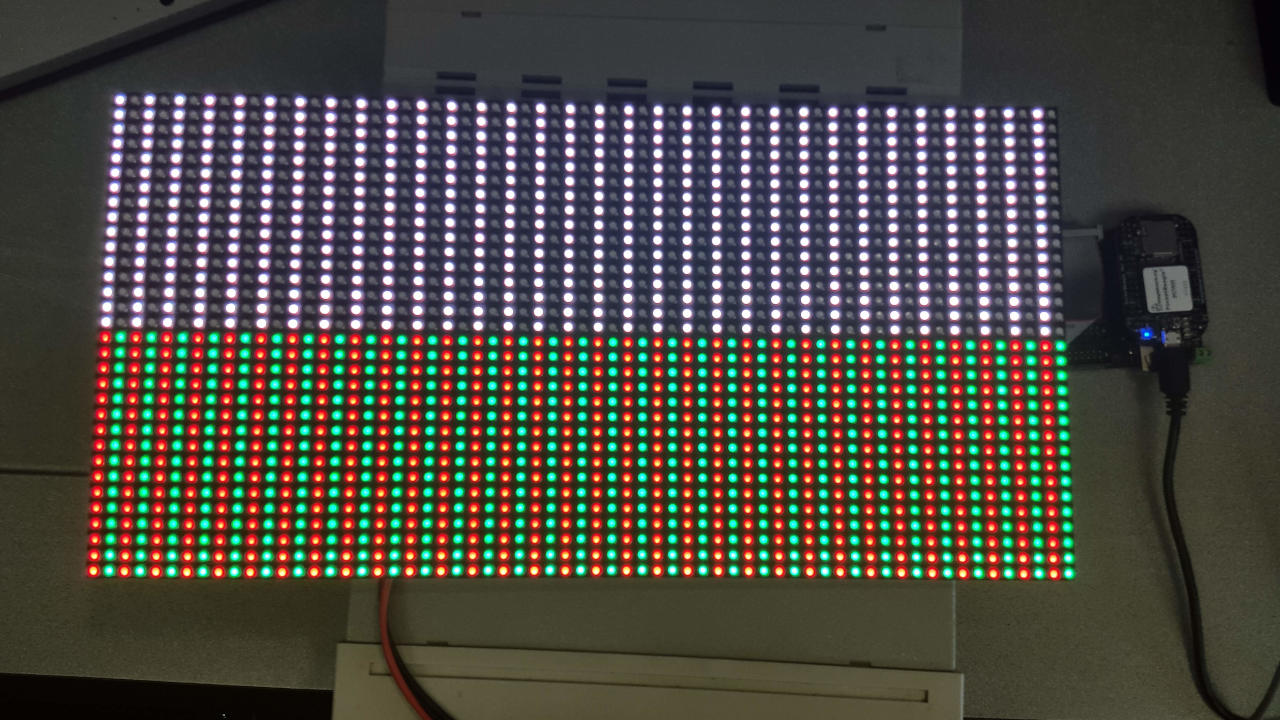
Fig. 526 Display running rgb1.c on PRU 0¶
The PRU is fast enough to quickly write to the display so that it appears as if all the LEDs are on at once.
Discussion¶
There are a lot of details needed to make this simple display work. Let’s go over some of them.
First, the connector looks like RGB Matrix J1 connector.
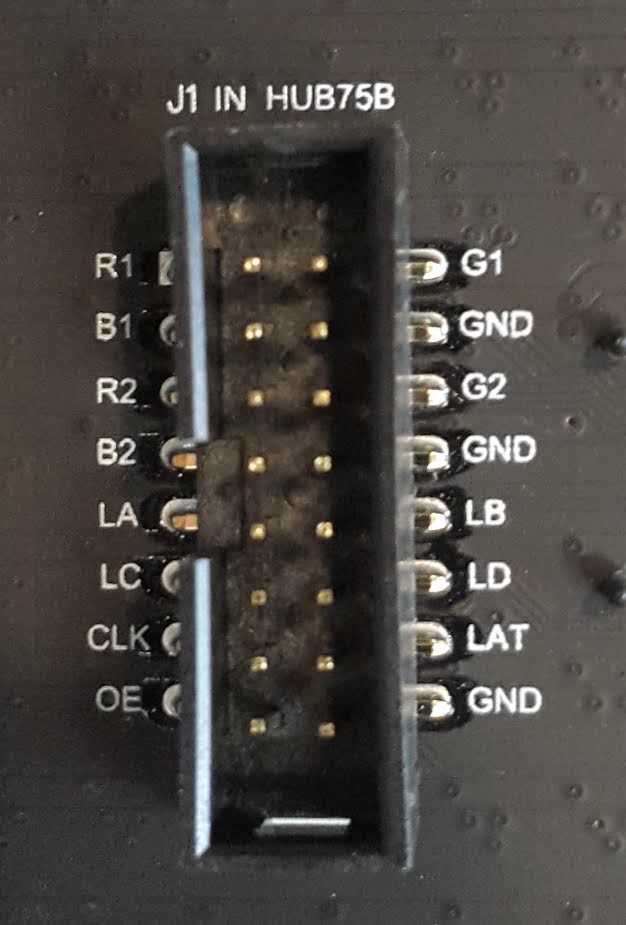
Fig. 527 RGB Matrix J1 connector¶
Notice the labels on the connect match the labels in the code. PocketScroller pin table shows how the pins on the display are mapped to the pins on the PocketBeagle.
Todo
Make a mapping table for the Black
https://github.com/FalconChristmas/fpp/blob/master/src/pru/OctoscrollerV2.hp
J1 Connector Pin |
Pocket Headers |
gpio port and bit number |
Linux gpio number |
PRU R30 bit number |
|---|---|---|---|---|
R1 |
P2_10 |
1-20 |
52 |
|
B1 |
P2_06 |
1-25 |
57 |
|
R2 |
P2_04 |
1-26 |
58 |
|
B2 |
P2_01 |
1-18 |
50 |
|
LA |
P2_32 |
3-16 |
112 |
PRU0.2 |
LC |
P1_31 |
3-18 |
114 |
PRU0.4 |
CLK |
P1_33 |
3-15 |
111 |
PRU0.1 |
OE |
P1_29 |
3-21 |
117 |
PRU0.7 |
G1 |
P2_08 |
1-28 |
60 |
|
G2 |
P2_02 |
1-27 |
59 |
|
LB |
P2_30 |
3-17 |
113 |
PRU0.3 |
LD |
P2_34 |
3-19 |
115 |
PRU0.5 |
LAT |
P1_36 |
3-14 |
110 |
PRU0.0 |
The J1 mapping to gpio port and bit number comes from https://github.com/FalconChristmas/fpp/blob/master/capes/pb/panels/PocketScroller.json. The gpio port and bit number mapping to Pocket Headers comes from https://docs.google.com/spreadsheets/d/1FRGvYOyW1RiNSEVprvstfJAVeapnASgDXHtxeDOjgqw/edit#gid=0.
Oscilloscope display of CLK, OE, LAT and R1 shows four of the signal waveforms driving the RGB LED matrix.
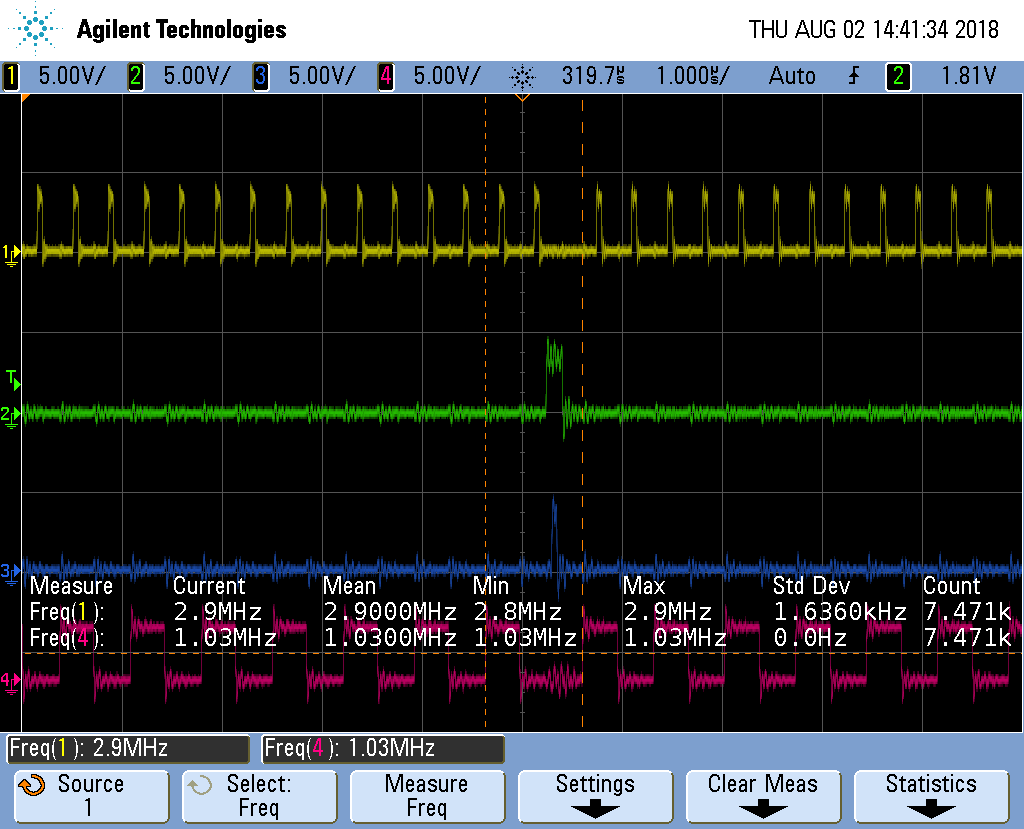
Fig. 528 Oscilloscope display of CLK, OE, LAT and R1¶
The top waveform is the CLK, the next is OE, followed by LAT and finally R1. The OE (output enable) is active low, so most of the time the display is visible. The sequence is:
Put data on the R1, G1, B1, R2, G2 and B2 lines
Toggle the clock.
Repeat the first two steps as one row of data is transferred. There are 384 LEDs (2 rows of 32 RGB LEDs times 3 LED per RGB), but we are clocking in six bits (R1, G1, etc.) at a time, so 384/6=64 values need to be clocked in.
Once all the values are in, disable the display (OE goes high)
Then toggle the latch (LAT) to latch the new data.
Turn the display back on.
Increment the address lines (LA, LB, LC and LD) to point to the next rows.
Keep repeating the above to keep the display lit.
Using the PRU we are able to run the clock a about 2.9 MKHz. FPP waveforms shows the optimized assembler code used by FPP clocks in at some 6.3 MHz. So the compiler is doing a pretty good job, but you can run some two times faster if you want to use assembly code. In fairness to FPP, it’s having to pull it’s data out of RAM to display it, so isn’t not a good comparison.
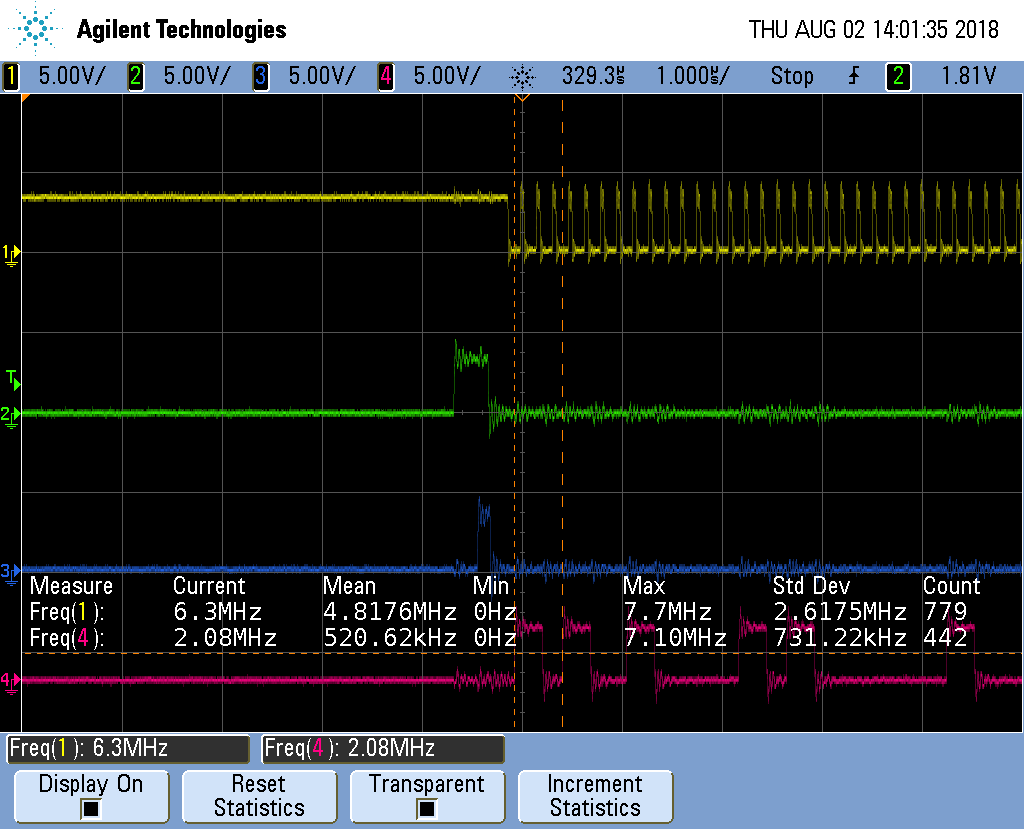
Fig. 529 FPP waveforms¶
Getting More Colors¶
The Adafruit description goes on to say:
information
The only downside of this technique is that despite being very simple and fast, it has no PWM control built-in! The controller can only set the LEDs on or off. So what do you do when you want full color? You actually need to draw the entire matrix over and over again at very high speeds to PWM the matrix manually. For that reason, you need to have a very fast controller (50 MHz is a minimum) if you want to do a lot of colors and motion video and have it look good.
https://cdn-learn.adafruit.com/downloads/pdf/32x16-32x32-rgb-led-matrix.pdf
This is what FPP does, but it’s beyond the scope of this project.
Compiling and Inserting rpmsg_pru¶
Problem¶
Your Beagle doesn’t have rpmsg_pru.
Solution¶
Do the following.
bone$ *cd code/05blocks/module*
bone$ *sudo apt install linux-headers-\`uname -r`*
bone$ *wget https://github.com/beagleboard/linux/raw/4.9/drivers/rpmsg/rpmsg_pru.c*
bone$ *make*
make -C /lib/modules/4.9.88-ti-r111/build M=$PWD
make[1]: Entering directory '/usr/src/linux-headers-4.9.88-ti-r111'
LD /home/debian/PRUCookbook/docs/code/05blocks/module/built-in.o
CC [M] /home/debian/PRUCookbook/docs/code/05blocks/module/rpmsg_client_sample.o
CC [M] /home/debian/PRUCookbook/docs/code/05blocks/module/rpmsg_pru.o
Building modules, stage 2.
MODPOST 2 modules
CC /home/debian/PRUCookbook/docs/code/05blocks/module/rpmsg_client_sample.mod.o
LD [M] /home/debian/PRUCookbook/docs/code/05blocks/module/rpmsg_client_sample.ko
CC /home/debian/PRUCookbook/docs/code/05blocks/module/rpmsg_pru.mod.o
LD [M] /home/debian/PRUCookbook/docs/code/05blocks/module/rpmsg_pru.ko
make[1]: Leaving directory '/usr/src/linux-headers-4.9.88-ti-r111'
bone$ *sudo insmod rpmsg_pru.ko*
bone$ *lsmod | grep rpm*
rpmsg_pru 5799 2
virtio_rpmsg_bus 13620 0
rpmsg_core 8537 2 rpmsg_pru,virtio_rpmsg_bus
It’s now installed and ready to go.
Copyright¶
1/*
2 * Copyright (C) 2015 Texas Instruments Incorporated - http://www.ti.com/
3 *
4 *
5 * Redistribution and use in source and binary forms, with or without
6 * modification, are permitted provided that the following conditions
7 * are met:
8 *
9 * * Redistributions of source code must retain the above copyright
10 * notice, this list of conditions and the following disclaimer.
11 *
12 * * Redistributions in binary form must reproduce the above copyright
13 * notice, this list of conditions and the following disclaimer in the
14 * documentation and/or other materials provided with the
15 * distribution.
16 *
17 * * Neither the name of Texas Instruments Incorporated nor the names of
18 * its contributors may be used to endorse or promote products derived
19 * from this software without specific prior written permission.
20 *
21 * THIS SOFTWARE IS PROVIDED BY THE COPYRIGHT HOLDERS AND CONTRIBUTORS
22 * "AS IS" AND ANY EXPRESS OR IMPLIED WARRANTIES, INCLUDING, BUT NOT
23 * LIMITED TO, THE IMPLIED WARRANTIES OF MERCHANTABILITY AND FITNESS FOR
24 * A PARTICULAR PURPOSE ARE DISCLAIMED. IN NO EVENT SHALL THE COPYRIGHT
25 * OWNER OR CONTRIBUTORS BE LIABLE FOR ANY DIRECT, INDIRECT, INCIDENTAL,
26 * SPECIAL, EXEMPLARY, OR CONSEQUENTIAL DAMAGES (INCLUDING, BUT NOT
27 * LIMITED TO, PROCUREMENT OF SUBSTITUTE GOODS OR SERVICES; LOSS OF USE,
28 * DATA, OR PROFITS; OR BUSINESS INTERRUPTION) HOWEVER CAUSED AND ON ANY
29 * THEORY OF LIABILITY, WHETHER IN CONTRACT, STRICT LIABILITY, OR TORT
30 * (INCLUDING NEGLIGENCE OR OTHERWISE) ARISING IN ANY WAY OUT OF THE USE
31 * OF THIS SOFTWARE, EVEN IF ADVISED OF THE POSSIBILITY OF SUCH DAMAGE.
32 */